Meeting of the
Finance Audit & Risk Sub-committee
Date: 2 March 2022
Time: 9.00am
|
Venue:
|
Council
Chamber
Hawke's
Bay Regional Council
159
Dalton Street
NAPIER
|
Agenda
Item Title Page
1. Welcome/Notices/Apologies
2. Conflict
of Interest Declarations
3. Confirmation of Minutes of
the Finance Audit & Risk Sub-committee meeting held on 15 December 2021
4. Six
Monthly Enterprise Risk Report 3
5. Risk
Maturity Update 35
6. Internal
Audit Annual Plan Status Update FY2021-2022 39
7. Annual
Internal Assurance Plan 2022-2023 41
8. 2020-2021
Annual Report Audit Update 45
9. Quarterly
Treasury Report for 1 October – 31 December 2021 49
10. HBRC
Forestry Update 79
11. Tūtira
Mānuka Plantation Update 103
12. Internal
Assurance Dashboard - Corrective Actions Status Update 117
13. Talent
Management Internal Audit Update 129
15. Scope
for Fund Manager Review (late item to come)
Public
Excluded
14. Internal
Assurance Dashboard - Cyber Security Corrective Actions Status Update 133
HAWKE’S BAY REGIONAL
COUNCIL
Finance
Audit & Risk Sub-committee
02 March
2022
Subject: Six Monthly Enterprise Risk
Report
Reason for Report
1. This item and the accompanying
enterprise risk report provide the Finance Audit and Risk Sub-committee (FARS)
with the six-monthly update of Council’s enterprise risk profile. The
update in the report includes the review of:
1.1. The enterprise risks and
risk descriptions
1.2. The inherent and residual
risk ratings for each enterprise risk
1.3. The overall control
assessment and control corrective actions for each enterprise risk
1.4. Supporting risk information
that may impact Council’s risk profile, including a regulatory/legal
update, business incidents, internal audits, material internal change projects,
and emerging issues or uncertainties.
Officers’
Recommendations
2. Council Officers recommend
that the Sub-committee notes the revised enterprise risks, control corrective
actions, and supporting risk information.
Background/Discussion
3. At the Regional Council
meeting held on 30 September 2020 the Risk Management Framework was approved by
Council. The Framework requires that the FARS receives and reviews the
enterprise risk report at least six monthly. Therefore, this paper presents to
the FARS the Council’s enterprise risk report as of February 2022.
4. In assessing the overall
residual risk ratings, the external emerging issues considered were:
4.1. Magnitude, broadness and
complexity of regulatory change that is likely to impact Council, including:
climate change national adaption plan, emissions reduction plan, resource
management reform, national standards for management of human drinking water
resources, national standards for freshwater amendments, and national standards
for air quality amendments
4.2. Covid-19 variant mutations
including New Zealand’s current Omicron outbreak and the impact of the
government lead response through the phased traffic light system, including
isolation and testing requirements, and the impact on supply chains
4.3. Economic outlook and
forecasts for interest and inflation rates
4.4. The competitive New Zealand
labour market and the labour market post border restrictions
4.5. Heightened geo-political
tensions with far reaching impacts on global financial markets e.g.
Ukraine/Russia
4.6. Climate change and global
climate action delays as the world responds to the immediate risks of: Covid-19
pandemic, economic instability (including asset bubbles), and geopolitical
tensions and the impact these global and national distractions may have on
Council’s strategy for climate change.
5. The following material
changes are noted in the February 2022 Enterprise Risk Report when compared to
the enterprise risk report presented to the FARS at the July 2021 meeting.
Risk
2 – Financial
5.1. The emerging issues noted
under bullet point four above are creating global and domestic uncertainties
within the financial markets. While Council’s financial
controls are effective at managing its financial position. The high
levels of uncertainties and current levels of volatility within the financial
markets has increased the residual likelihood assessment to
‘Likely’ and the overall financial impact to
‘Moderate’. With the overall residual risk rating increasing
to ‘Medium’. This risk is
being closely monitored by the Finance Team and constantly reviewed by the
Leadership team.
Risk
8 – Business Interruption
5.2. In response to the recent
Omicron Covid-19 outbreak and associated isolation mandates, Council’s pandemic plan was updated
to include:
5.2.1. mandating of vaccinations
for Council employees
5.2.2. work bubbles for all
critical roles
5.2.3. surgical masks for all
staff
5.2.4. Covid-19 passport
verification and sign in for Dalton Street and Station Street
‘private’ areas
5.2.5. Covid-19 sign-in and
physical distancing for meetings in the Council Chamber
5.2.6. access to rapid antigen
tests (RATS). It is noted the pandemic plan remains fluid and is continually
reviewed and updated by management to ensure that it remains relevant to the
evolving situation.
5.3. However, due to the Omicron
outbreak and associated
isolation rules the business interruption likelihood assess has been elevated
to ‘almost certain’. While additional measures in the pandemic plan
limit the extent of isolation requirements for Council staff. Council
needs to engage with strategic partners such as landowners and others in the
community to deliver on strategic activities. Therefore, it is almost certain
execution of some strategic objectives for FY2022 will be impacted, however,
the extent of that impact remains unchanged as ‘moderate. The overall
residual risk rating for this risk has therefore increased from
‘medium’ to ‘high’.
5.4. It is noted that the tight
labour market and risks associated work pressures on staff to cover vacant
positions, is being monitored under risk nine ‘People Capability’.
The convergence of the tight labour market coupled with alternate working
arrangements due to the Omicron outbreak could potentially elevate this
business interruption risk impact. Therefore, staff vacancies are being closely
monitored through the Omicron outbreak.
5.5. It is also noted that, late
2021 in response to the growing Covid threat from emerging mutations and border
containment breaches, a review of Council’s resilience to supply chain
disruption was undertaken. Council’s suppliers of business-critical
goods/services were proactively contacted and where necessary additional stocks
were procured to ensure that the Hawke’s Bay Regional Council (HBRC)
could operate independently and uninterrupted for a period of at least three
months. The review also considered the level of critical stock and spares
required should HBRC be required to respond to a regional crisis in addition to
Covid-19. New processes have also been established so that if key supply chains
become disrupted a review of supplies will be undertaken two months before supplies
are depleted.
Risk
9 – People Capability
5.6. Three aspects where
consider when assessing the overall residual rating of this risk covering
short-, medium- and longer-term uncertainties. The short-term uncertainties
(immediate risks) are driving the overall residual risk rating of
‘high’.
Medium
Term
5.7. The overall residual risk
rating for this risk was reported in the last risk report as
‘medium’ which was an elevated assessment. The elevated assessment
reflected the internal
audit of Council’s talent management framework/system which determined a
low level of maturity. And, while the talent management (P&C) strategy is
drafted implementation of the elements required to mature the framework will
take time. Maturity of Council’s talent management framework will help to
manage Council’s people capability risk, both day to day and in more
challenging times. However, it is recognised that maturity of the talent
management framework alone will not necessarily be enough to ensure a positive
staff experience. The corporate plan is designed to look more holistically at
Council’s culture, processes, frameworks and systems to ensure these are
effective in design to enable staff to work ‘smarter’ and execute
on strategy (see the longer-term update below).
Longer Term
5.8. A Corporate Plan has been
developed and is continually being refined and improved. The plan is currently
being reviewed to ensure that as the organisation grows and matures its key
management frameworks/systems the subsequent maturity activities are
prioritised to ensure foundational elements that help the operational business
work ‘smarter’ are addressed first. Also, that as these maturity
activities are rolled out and embedded into the business-related changes to the
way the business operates are effectively managed and sustained within
Council’s operating rhythm. The management of change also ensures that
potential disruption and impacts to staff due to the maturity of key management
frameworks are anticipated and minimised.
Short
Term (immediate risk)
5.9. An outcome of NZ’s
response to Covid-19 and the prolonged closures of borders has meant
unemployment has fallen and the employment market is highly competitive.
Without a mature talent management framework there is real pressure on
responding to the immediate people risk and minimise the convergence this risk
has on Council’s business interruption risk. Therefore, due to the
immediate employment market pressures the likelihood of this risk has now been
elevated to ‘almost certain’ while the impact assessment has
remained unchanged as ‘moderate’. The overall residual risk rating
has increased to ‘high’. The People and Capability (P&C) team,
together with management, are working through short term mitigations for this
risk which includes reviewing all strategic and smaller team projects them
applying a risk-based lens to determine which of these projects or project
milestones maybe paused without significantly disrupting delivery of key
strategic objectives. Where practical ‘people’ resources assigned
these projects can then be redeployed to areas with an immediate need.
6. Lastly, given
Council’s mandate for visibility and aesthetics consideration was given
to including climate change as a separate risk on the enterprise risk report.
Climate change is currently weaved through all relevant enterprise risks and
documented in those risks as either a risk cause or impact and therefore
explicitly considered in each of those risk assessments. Consequently, climate
change has not been added as a standalone risk. However, the Climate Change
Ambassador recently started at Council. A formal review of climate change will
be undertaken with the Ambassador’s to leverage off her technical
expertise. Therefore, inclusion of a separate enterprise climate changes will
be reconsidered then.
Strategic Fit
7. The six-monthly risk report
facilitates discussions to ensure that any emerging matters within the
Council’s internal and external environment are being managed. And,
therefore unlikely to impact on the Council’s ability to deliver on its
strategy. In addition, the maturity of the Council’s risk management
system contributes towards achieving excellence in execution of strategy. A
mature risk system provides consistent risk intelligent decision making
enabling the efficient prioritisation of finite organisational resources to
deliver on strategy.
Financial
and Resource Implications
8. There are no additional or
significant budgetary requirements resulting from control corrective actions
noted within the risk report that have not already been accounted for through
the LTP or BAU activities.
Decision Making Process
9. Council and its committees
are required to make every decision in accordance with the requirements of the
Local Government Act 2002 (the Act). Staff have assessed the requirements in
relation to this item and have concluded:
9.1. The decision of the
Sub-committee is in accordance with the Terms of Reference and decision-making
delegations adopted by Hawke’s Bay Regional Council on 25 March
2020, specifically the Finance, Audit and Risk Sub-committee shall have
responsibility and authority to:
9.1.1. Review whether Council
management has a current and comprehensive risk management framework and
associated procedures for effective identification and management of the
council’s significant risks in place
9.1.2. Undertake periodic
monitoring of corporate risk assessment, and the internal controls instituted
in response to such risks
9.1.3. report on the robustness of
risk management systems, processes and practices to the Corporate and Strategic
Committee to fulfil its responsibilities.
Recommendations
That the Finance, Audit and Risk
Sub-committee:
1. Receives and considers the
“Six Monthly Enterprise Risk” staff report.
2. Reports to the Corporate
and Strategic Committee, the Sub-committee’s satisfaction that the Six-Monthly
Enterprise Risk Report provides adequate evidence of the robustness of
Council’s risk management policy and framework and progress to implement
the maturing risk management system.
Authored by:
|
Helen Marsden
Risk & Corporate Compliance
Manager
|
|
Approved by:
|
Jessica Ellerm
Group Manager Corporate Services
|
|
Attachmen
|
1⇩
|
February 2022 Enterprise Risk Report
|
|
|
|
February
2022 Enterprise Risk Report
|
Attachment 1
|























HAWKE’S BAY REGIONAL
COUNCIL
Finance
Audit & Risk Sub-committee
02 March
2022
Subject: Risk Maturity Update
Reason for Report
1. This item provides the
Finance, Audit and Risk Sub-committee (FARS) with an update on Council’s Risk Management Maturity.
Background
2. At the Corporate and
Strategic (C&S) Committee meeting on 10 June 2020 Council’s risk
maturity roadmap was endorsed. At that meeting it was agreed that the
FARS would take responsibility for overseeing the implementation of the risk
maturity roadmap. Therefore, this item provides a summary of risk
maturity actions completed since last reported to FARS on 13 October 2021
and risk maturity actions scheduled for the next FARS reporting period.
Discussion
3. The last update to the
Sub-committee was in October 2021. Since October 2021 the following risk
maturity actions have been completed:
3.1. Appointment of a Risk
Champion within each Group – the Risk Champion will coordinate the
development of risk profiles for each Group and influence risk attitudes to
ensure alignment across the business
3.2. Inclusion of Risk Champions
in a ‘light touch’ risk aggregation session to provide bottom-up
challenge to the current enterprise risk profile
3.3. Completion of risk bowties
for each enterprise risk
3.4. A session with the Strategy
and Governance Team to identify risk processes to formalise within strategy and
governance e.g., inclusion of a formal risk sign-off in concept documents
(business cases), decision papers, and project scope variations.
4. For the next FARS reporting
period the risk maturity plan had intended to target formal training of the
Risk Champions and the development of a risk profiles for each Group.
Developing a risk profile for each Group would help to upskill Managers and key
subject matter experts in risk-based thinking and systematically embed risk
methodologies into the business. However, currently the business is
facing significant disruption with responding to immediate high impact risks of
Covid19 and a tight employment market. Therefore, phase IV of the roadmap
(see image below) has been re-evaluated to identify a less resource intensive
approach to embedding risk.

5. It is agreed that the focus
for the next reporting period will be on partnering with staff across functions
to develop Key Risk Indicators (KRI’s) and utilise the draft risk
appetite to drive consistent messaging and risk tolerances for identified
indicators. The Strategy and Performance team have already developed
financial and non-financial performance reporting via the Quarterly
Organisational Performance Report that includes several KRI metrics.
Therefore, the intention is to work collaboratively with the Strategy and
Performance team and KRI metric owners to determine tolerance levels bringing
risk monitoring and corrective actions closer to performance outcomes. In
addition, strengthening the risk bowties and identified critical controls for
each enterprise risk may enable new KRI metrics to be identified that could
further strengthen the non-financial performance part of the report.
6. Therefore, the following
actions are now scheduled to be delivered as part of the risk maturity roadmap
over the next FARS reporting period:
6.1. External validation on the
completeness and accuracy of the enterprise bowties including identifying
opportunities to enhance critical controls.
6.2. Using validated bowties to
identify new KRI metrics to enhance the Organisational Performance Report.
6.3. Working collaboratively
with the Strategy and Performance team to identify key KRI’s in the
current Organisational Performance Report, upskill metric owners in risk based
thinking to improve qualitative reporting (i.e. commentary provided) and establish
risk tolerance levels (triggers) as guided by Council’s risk appetite
statement.
6.4. Continue with informal risk
aggregation sessions (light touch meetings) with Risk Champions.
6.5. Progress the formulation of
Council’s risk appetite statement including reviewing the Risk Management
Framework and Policy with particular attention on the quantitative scale in the
risk matrix.
Strategic Fit
7. Maturity of the
Council’s risk management system contributes towards achieving all
strategic goals/vision by protecting the organisation. A mature risk system
provides consistent risk intelligent decision making enabling the efficient
prioritisation of finite organisational resources to deliver on strategy.
Financial and Resource Implications
8. Maturity of the risk
management system is phased to minimise budgetary implications. Some
facilitated risk training workshops maybe need to be provided to targeted
staff. The 0.1 Risk Champion FTE from each Group will be managed through
current resourcing.
Next Steps
9. Refer to section six of
this report for the next steps for maturity of the Council’s risk
management system.
Decision Making Process
10. Council and its committees
are required to make every decision in accordance with the requirements of the
Local Government Act 2002 (the Act). Staff have assessed the requirements in
relation to this item and have concluded:
10.1. The decision of the
sub-committee is in accordance with the Terms of Reference and decision-making
delegations adopted by Hawke’s Bay Regional Council 25 March 2020,
specifically the Finance, Audit and Risk Sub-committee shall have
responsibility and authority to:
10.1.1. Review whether Council
management has a current and comprehensive risk management framework and
associated procedures for effective identification and management of the
council’s significant risks in place.
10.1.2. Undertake periodic
monitoring of corporate risk assessment, and the internal controls instituted
in response to such risks.
10.1.3. Report on the
robustness of risk management systems, processes and practices to the Corporate
and Strategic Committee to fulfil its responsibilities.
10.2. As this
report is for information only, the decision-making provisions do not apply.
Recommendations
1. That the Finance, Audit and
Risk Sub-committee receives and considers the “Risk Maturity Update” staff report.
2. The Finance, Audit and Risk
Sub-committee reports
to the Corporate and Strategic Committee that:
2.1. Delivery of phase IV of the
roadmap was re-evaluated to identify a less resource intensive approach for
embedding risk-based thinking into the business due to the level of business
disruption from Covid19 and the tight labour market, and
2.2. The revised delivery plan
for phase IV of the roadmap still aligns to Council’s overall risk
maturity strategy of embedding risk-based thinking into the business.
Authored by:
|
Helen Marsden
Risk & Corporate Compliance
Manager
|
Desiree Cull
Strategy & Governance Manager
|
Approved by:
|
Jessica Ellerm
Group Manager Corporate Services
|
|
Attachment/s
There are no attachments for this
report.
HAWKE’S
BAY REGIONAL COUNCIL
Finance
Audit & Risk Sub-committee
02 March
2022
Subject: Internal Audit Annual Plan
Status Update FY2021-2022
Reason for Report
1. This item provides the
Finance Audit and Risk Sub-committee (FARS) with the Internal
Audit Annual Plan FY21-22 status update.
Officers’
Recommendations
2. Council officers recommend
that the FARS members consider and note the Internal Audit Annual Plan FY21-22
status update below.
2.1. The Fraud Management audit
carried out by Crowe commenced in mid-February, interviews with a range of
staff have been held. The full report will be submitted to FARS in May
2022.
|
Approved Audit FY2021-22
|
Provider
|
Quarter Due
|
Date Commenced
|
Management Comments
|
Reported to FARS
|
|
Fraud Management
|
Crowe
|
Q3
|
February 2022
|
|
|
|
Data Analytics
|
Crowe
|
Q4
|
|
Due to commence in May 2022
|
|
|
Retained Audit Capacity – 40 hrs
|
|
|
|
|
|
3. The purpose of the annual
internal audit plan status update dashboard is to provide the FARS with
oversight and progress of individual internal audits that form part of the
Corporate and Strategic Committee (C&S) approved annual internal audit
plan.
Decision Making Process
4. Council and its committees
are required to make every decision in accordance with the requirements of the
Local Government Act 2002 (the Act). Staff have assessed the requirements in
relation to this item and have concluded:
4.1. This agenda item is in
accordance with the Sub-committee’s Terms of Reference, specifically:
4.1.1. The purpose of the Finance,
Audit and Risk Sub-committee is to report to the Corporate and Strategic
Committee to fulfil its responsibilities for (1.3) the independence and
adequacy of internal and external audit functions
4.1.2. The Finance, Audit and Risk
Sub-committee shall have responsibility and authority to (2.6) receive the
internal and external audit report(s) and review actions to be taken by
management on significant issues and recommendations raised within the
report(s)
4.1.3. The Finance, Audit and Risk
Sub-committee is delegated by Council to (3.6) review the objectives and scope
of the internal audit function, and ensure those objectives are aligned with
Council’s overall risk management framework; and (3.7) assess the
performance of the internal audit function, and ensure that the function is
adequately resourced and has appropriate authority and standing within Council.
Recommendations
That the Finance, Audit and Risk
Sub-committee:
1. Receives and considers the
“Internal Audit Annual Plan Status Update FY2021-2022” staff
report.
2. Reports to the Corporate
and Strategic Committee, the Sub-committee’s satisfaction that the Internal
Assurance Programme Update provides adequate evidence of the adequacy of
Council’s internal assurance functions and management actions undertaken
or planned respond to findings and recommendations from completed internal
audits.
Authored by:
|
Olivia Giraud-Burrell
Quality & Assurance Advisor
|
Helen Marsden
Risk & Corporate Compliance
Manager
|
Approved by:
|
Jessica Ellerm
Group Manager Corporate Services
|
|
Attachment/s
There are no attachments for this
report.
HAWKE’S
BAY REGIONAL COUNCIL
Finance
Audit & Risk Sub-committee
02 March
2022
Subject: Annual Internal Assurance
Plan 2022-2023
Reason for Report
1. This item provides the
Finance Audit and Risk Sub-committee (FARS) with a draft proposed Annual
Internal Assurance Plan 2022-2023 for consideration as requested at FARS
October 2021.
Background/Discussion
2. Council officers recommend
that the Sub-committee considers the proposed Plan. An outline of current
trends is provided below by our current internal auditors (Crowe) which is aligned
to the Office of the Auditor- General’s areas of focus. A detailed report
will be provided at the 4 May 2022 FARS meeting and seek the
Sub-committee’s approval of the 2022-2023 Plan.
2.1. Business continuity
planning
2.2. Integrity and Ethics (covered
by the planned Fraud Risk Management and Analytics assignments)
2.3. Infrastructure and asset
management (although limited to an extent by the 3 waters reforms)
2.4. Capital works programme
management
2.5. Information/Cybersecurity
2.6. People and Capability
(completed last year)
2.7. Climate change and
sustainability in service delivery.
Financial and Resource Implications
3. There are no financial
implications or additional resource requirements resulting from this internal
assurance programme update.
Decision Making Process
4. Council and its committees
are required to make every decision in accordance with the requirements of the
Local Government Act 2002 (the Act). Staff have assessed the requirements in
relation to this item and have concluded:
4.1. The agenda item is in
accordance with the Sub-committee’s Terms of Reference, specifically:
4.1.1. The purpose of the Finance,
Audit and Risk Sub-committee is to report to the Corporate and Strategic
Committee to fulfil its responsibilities for (1.3) the independence and
adequacy of internal and external audit functions
4.1.2. The Finance, Audit and Risk
Sub-committee shall have responsibility and authority to (2.6) receive the
internal and external audit report(s) and review actions to be taken by
management on significant issues and recommendations raised within the
report(s)
4.1.3. The Finance, Audit and Risk
Sub-committee is delegated by Council to (3.6) review the objectives and scope
of the internal audit function, and ensure those objectives are aligned with
Council’s overall risk management framework; and (3.7) assess the
performance of the internal audit function, and ensure that the function is
adequately resourced and has appropriate authority and standing within Council.
4.2. As this item is for
information only, the decision making provisions do not apply.
Recommendations
That
the Finance, Audit and Risk Sub-committee receives and considers the draft
“Annual
Internal Assurance Plan 2022-2023” staff report.
Authored by:
|
Olivia Giraud-Burrell
Quality & Assurance Advisor
|
Helen Marsden
Risk & Corporate Compliance
Manager
|
Approved by:
|
Tom Skerman
Regional Water Security Programme
Director
|
Jessica Ellerm
Group Manager Corporate Services
|
Attachment/s
|
1⇩
|
Annual Internal Assurance Plan
(universe)
|
|
|
|
Annual
Internal Assurance Plan (universe)
|
Attachment 1
|

HAWKE’S
BAY REGIONAL COUNCIL
Finance
Audit & Risk Sub-committee
02 March
2022
Subject: 2020-2021 Annual Report Audit
Update
Reason for Report
1. This item provides an
update on the audit of Council’s 2020-2021 Annual Report and timing for
Council adoption.
Background
2. Staff presented the
Hawke’s Bay Regional Council Annual Report for the 2020-2021 financial
year to the Finance, Audit and Risk Sub-committee on 15 December 2021, noting
the final audit report was yet to be received and adjustments might be
required.
3. The sub-committee
recommended that Hawke’s Bay Regional Council adopt the 2020-2021 Annual
Report, pending receipt of Audit New Zealand’s final audit report and
subject to any minor adjustments.
Audit
update
4. Council staff had
anticipated bringing the Annual Report to Council for adoption in January 2022,
however due to delays with Audit NZ completing their audit, expect to now bring
it to Council at its meeting in March.
5. The delay is due to Audit
NZ’s technical team working through the best treatment for the Accident
Compensation Corporation adjustment.
Feedback incorporated since last FARS meeting
6. At the December
sub-committee meeting, a member raised an issue with how leave entitlements and
liabilities were presented. Finance staff responded directly to the member to
explain that it was to do with the difference between how information is
presented by HBRC and the Port (which is consolidated into HBRIC and the HBRC
Group accounts). No change was required. .
7. A number of small
adjustments to the Annual Report and Summary have been made. These were either
as a result of audit feedback or improvement/corrections made by staff.
8. As stated in December,
staff would bring revised financial statements back to the sub-committee for
further review only if they were considered significant in nature.
Implication of Late Adoption
9. Under the Local Government
Act 2020 (the Act), the Annual Report and Summary are statutory requirements
and required to be audited by an independent auditor.
10. Legislation[1] was passed in July
2021 to extend the statutory deadline for adoption of both the 2020-2021 and
2021-2022 Annual Reports (with 30 June balance dates) by two months due to a
severe shortage of auditors. That means that those annual reports must be
adopted no later than 31 December in their respective year.
11. As we will be adopting
after that date, we are required to include a self-disclosure note in our
financial statements. The Regional Council will be included in the audit
statistics reported to central government.
12. A late adoption does not
affect our Level of Service Measure in our Long Term Plan 2021-2031 related to
a clear audited opinion.
13. Interim non-financial and
financial results, prior to being audited, have been in the public arena
multiple times via committee agendas.
Audit
NZ
14. Karen Young, Director of
Audit NZ, will be joining this meeting as per the FARS terms of reference, to
discuss any matters that the auditors wish to bring to the
Sub-committee’s attention. This can be a members-only session if required.
15. Should the sub-committee
wish to discuss matters with the Auditor in private, with the public excluded,
the following resolution must be passed.
15.1. That the Finance, Audit and
Risk Sub-committee excludes the public from this section of the meeting being
Discussion with Director of Audit NZ with the general subject of the item to be
considered while the public is excluded; the reasons for passing the resolution
and the specific grounds under Section 48 (1) of the Local Government Official Information
and Meetings Act 1987 for the passing of this resolution being:
|
General
Subject of the Item to be Considered
|
Reason
for Passing This Resolution
|
Grounds
Under Section 48(1) for the Passing of the Resolution
|
|
2020-2021 HBRC Annual Report Audit
|
7(2)(c)(i) The exclusion of the public from this
discussion is necessary to protect information which is subject to an
obligation of confidence and to ensure the supply of similar information from
the same source is not prejudiced; it is in the public interest that such
information should continue to be supplied
|
The Council is specified, in the First
Schedule to this Act, as a body to which the Act applies.
|
|
2020-2021 HBRC Annual Report Audit
|
7(2)(f)(ii) The exclusion of the public from this
discussion is necessary to maintain the effective conduct of public affairs
through the protection of such members, officers, employees, and persons from
improper pressure or harassment
|
The Council is specified, in the First
Schedule to this Act, as a body to which the Act applies.
|
Decision Making Process
16. The Regional Council and
its committees are required to make every decision in accordance with the
requirements of the Local Government Act 2002 (the Act). Staff have assessed
the requirements in relation to this item and have concluded:
16.1. The decisions are in
accordance with the Finance, Audit and Risk Sub-committee Terms of Reference,
specifically to:
16.1.1. Satisfy itself that the
financial statements and statements of service performance are supported by
adequate management signoff and adequate internal controls and recommend
adoption of the Annual Report by Council
16.1.2. Enquire of internal and
external auditors for any information that affects the quality and clarity of
the Council’s financial statements and statements of service performance,
and assess whether appropriate action has been taken by management in response
to this
16.1.3. Conduct a sub-committee
members-only session with Audit NZ to discuss any matters that the auditors
wish to bring to the Sub-committee’s attention and/or any issues of
independence
16.2. as this report is for
information only, the decision-making provisions do not apply.
Recommendations
1. That the Finance, Audit and
Risk Sub-committee receives and notes the “2020-21 Annual Report Audit Update” staff report.
And if required
2. That the Finance, Audit and
Risk Sub-committee excludes the public from this section
of the meeting being Discussion with Director of Audit NZ with the general
subject of the item to be considered while the public is excluded; the reasons
for passing the resolution and the specific grounds under Section 48 (1) of the
Local Government Official Information and Meetings Act 1987 for the passing of
this resolution being:
|
General
Subject of the Item to be Considered
|
Reason
for Passing This Resolution
|
Grounds
Under Section 48(1) for the Passing of the Resolution
|
|
2020-2021 HBRC Annual Report Audit
|
7(2)(c)(i) The exclusion of the public from this
discussion is necessary to protect information which is subject to an
obligation of confidence and to ensure the supply of similar information from
the same source is not prejudiced; it is in the public interest that such information
should continue to be supplied
|
The Council is specified, in the First
Schedule to this Act, as a body to which the Act applies.
|
|
2020-2021 HBRC Annual Report Audit
|
7(2)(f)(ii) The exclusion of the public from this
discussion is necessary to maintain the effective conduct of public affairs
through the protection of such members, officers, employees, and persons from
improper pressure or harassment
|
The Council is specified, in the First
Schedule to this Act, as a body to which the Act applies.
|
Authored by:
|
Tim Chaplin
Senior Group Accountant
|
Mandy Sharpe
Project Manager
|
|
Desiree Cull
Strategy & Governance Manager
|
Christopher Comber
Chief Financial Officer
|
Approved by:
|
Jessica Ellerm
Group Manager Corporate Services
|
|
Attachment/s
There are no attachments for this
report.
HAWKE’S
BAY REGIONAL COUNCIL
Finance
Audit & Risk Sub-committee
2 March
2022
Subject: Quarterly Treasury Report for
1 October – 31 December 2021
Reason for Report
1. This item provides
compliance monitoring of Hawke’s Bay Regional Council (HBRC) treasury
activity and reports the performance of Council’s investment portfolio
for the quarter ended 31 December 2021.
Overview of the Quarter – ending 31 December 2021
2. At the end of the quarter
to 31 December 2021, HBRC was compliant with all measures in its Treasury
policy except for the Mercer SIPO investment allocation, which has since been
corrected.
3. Investment returns for the
first 6 months met budget expectations, however, due to market volatility and a
significant financial market adjustment in January 2022, it is too early to
predict the returns for the full financial year. The fluctuation in January
erased most of the gains of the first 6 months so a recovery in the markets is
required to deliver target returns for the year.
4. Financial markets,
particularly international markets, continue to move around considerably and a
bounce back to forecast returns within the financial year is not out of the
question. Staff advice is to watch and wait at this point in time, corrective
action is not required, and the portfolio is well balanced for the long term.
5. Cash balances are good and
borrowing requirements low for the first 6 months. As Council progresses
further into the financial year additional borrowing will be required.
Financial Impact of Covid-19 / Omicron on Current and Future
Financial Year
6. The sub-committee requested
that a financial assessment, including commentary regarding any corrective
actions required, of the financial impact of the current Omicron outbreak on
FY21-22 be incorporated within this Treasury report. However, given the 6-month
financials to 31 December 2021 will be presented to the Corporate and
Strategic Committee alongside the organisation performance reporting on 16
March 2022, the financial impact commentary is best placed to accompany that
reporting.
7. Financial impacts of
Covid/Omicron are both direct and indirect and include adjustments or impacts
to budget assumptions for inflation, interest costs. Additional expenses may be
incurred in relation to business continuity/resilience planning, (working from
home equipment/cleaning/masks etc), direct staff costs where there is a
requirement to add resourcing for critical stand-alone roles. There may,
however, be costs savings or deferral of spend where capital work programmes
are not being delivered within planned timeframes because of the
disruption/distraction. The most significant financial impact will likely be to
investment income, where impact to financial markets can be immediate and high
impact.
8. All of the above will be
incorporated into the financial reporting for the 16 March 2022 Corporate and
Strategic Committee meeting.
Background
9. Council’s Treasury
Policy requires a quarterly Treasury Report to be presented to the Finance
Audit and Risk Sub-committee. The policy states that the Treasury Report is to
include:
9.1. Treasury Exceptions report
9.2. Policy compliance
9.3. Borrowing Limit report
9.4. Funding and liquidity
report
9.5. Debt maturity profile
Interest rate report
9.6. Investment management
report**
9.7. Treasury investments
9.8. Cost of funds report Cash
flow and debt forecast report
9.9. Debt and interest rate
strategy and commentary
9.10. Counterparty credit report
9.11. Loan advances.
10. The Investment Management
report** has specific requirements outlined in the Treasury Policy. This
requires quarterly reporting on all treasury investments plus annual reporting
on all equities and property investments.
11. In addition to the Treasury
Policy, Council has a Statement of Investment Policy and Objectives (SIPO)
document setting out the parameters required for funds under management for the
HBRC Long Term Investment Fund.
12. Treasury Investments to be
reported on consist of:
12.1. Liquidity
12.1.1. Cash and Cash Equivalents
12.1.2. Debt Management
12.2. Externally Managed
Investment Funds
12.2.1. Long-Term Investment Fund
(LTIF)
12.2.2. Future Investment Fund
(FIF)
12.3. Investment properties
12.4. HBRIC Ltd
12.5. 2021-22 Performance
Summary.
13. Since 2018, HBRC has
procured treasury advice and services from PriceWaterhouseCoopers (PwC) and
their quarterly compliance report is attached.
Discussion
14. A separate treasury report
is prepared by Council’s advisors, PwC to report on compliance with the
policy parameters and investment performance. The PwC report is attached. This
report gives a high-level summary of the data in the PwC report.
Liquidity
15. To ensure HBRC has the
ability to adequately fund its operations, current policy requires HBRC to
maintain a liquid balance of $3.0m.
16. The following table reports
the cash and cash equivalents on 31 December 2021.
|
31 December 2021
|
$000
|
|
Cash on Call
|
15,915
|
|
Short-term bank deposits
|
2,000
|
|
Total Cash & and Deposits
|
17,916
|
17. Council’s balance of
cash and deposits compares favourably with the December 2020 balance of $13.5m.
18. To manage HBRC liquidity
risk, HBRC also retains a Standby Facility with BNZ.
This facility provides HBRC with a same day draw down option, to any amount
between $0.3-$5.0m, and with a 7-day minimum draw period.
Debt
Management
19. On 31 December 2021 the
current external debt for the Council group was $40.3m ($56.96m including the
loan from HBRIC).
20. Following the $11m raised
in the September quarter no further funds were borrowed in the December
quarter. This was as anticipated given Council’s cash position is at its
best in the December quarter (due to rates being due in September).
21. Further borrowing will be
required in the second half of the financial year (first half of calendar year
2022) as the requirements of the proposed 2021-2022 borrowing programme of
$27.5m ramps up.
22. The following summarises
the Year-to-date movements in Council’s debt position.
Summary of HBRC Debt
|
|
HBRC only
|
HBRC Group
|
|
Opening Debt – 1 July 2021 – excl HBRIC
Loan
|
30,875,014
|
30,875,014
|
|
New Loans raised
|
11,000,000
|
11,000,000
|
|
Less amounts repaid
|
(1,574,998)
|
(1,574,998)
|
|
Closing Debt 31 December 2021 (excluding
HBRIC loan)
|
40,300,016
|
40,300,016
|
|
Plus opening balance - loan from HBRIC
|
16,663,036
|
-
|
|
Total Borrowing as at 31 December
|
56,963,052
|
40,300,016
|
Managed
Funds
23. The LTP budgets an annual
return of 5.16% from managed funds. Of this 3.16% is used to fund activities
with 2.0% retained to grow the capital base to enable the future earnings to
protect the capital base for future generations.
24. Council budgets separately
for revenue from directly held managed funds and those held by HBRIC. HBRIC is
required to deliver an overall portfolio return by way of an agreed annual
dividend agreed through an annual Statement of Intent. The composition (between
revenues from managed funds and other sources such as port dividends is up to
the HBRIC board). Council has budgeted to receive $10.1 in dividends from HBRIC
within the FY21-22.
25. The FY21-22 budget
expectation for managed funds to be withdrawn to support Council operations is
$3.7m. Based on the December funds result and the value above the protected
amount the funds held sufficient returns to meet Council’s requirements.
Unfortunately, since 31 December the markets dropped eroding in excess of
$2m of these gains. A recovery of the market is now required to deliver on
budget expectations.
26. The Fund performances for
the first 6 months have been lower than we have experienced recently. Financial
markets have not performed as strongly as prior year with the YTP results for
the two providers being 0.9% and 1% so far. This follows on from annualized
returns of 12.5% and 14.5% for the 2020-21 financial year.
27. Given the nature of the
investments some volatility is to be expected. It is too early to predict
likely returns for the full year, however, if the remaining quarters deliver
similar results the annualised return would be approximately 4% which is below
the LTP budget of 5.16% p.a.
28. However, the performance of
the managed funds since placement demonstrate market recovery can occur within
relatively short timeframes, and a watch and wait approach is prudent. The
portfolio construct is intentionally conservatively balanced for the long-term.
29. The presentation of table
below has been changed from previous reports to show the combined view of funds
and the value available above the capital protected sum. As at June 2021
Council had an additional $3.36m available due to the stronger investment
returns in FY20-21. Some of this could be used to supplement any shortfall if
the current lower returns continue to the end of the financial year.
30. The following table summarises the fund balances at the
end of each quarter.
31. The view for the June,
September and December 2021 quarters has been expanded to show the total group
balance of managed funds (including HBRIC) and the amount by which the current
funds balance exceeds the capital protected amount.
|
|
31 Dec 2020
|
31 Mar 2021
|
30 Jun 2021
|
30 Sep 2021
|
31 Dec 2021
|
|
|
$000
|
$000
|
$000
|
$000
|
$000
|
|
Total funds before withdrawals
|
121,404
|
114,625
|
118,563
|
115,745
|
118,221
|
|
Funds withdrawn
|
(6,500)
|
|
(4,200)
|
|
|
|
Fund Balance HBRC
|
114,904
|
114,625
|
114,363
|
115,745
|
118,221
|
|
Capital Protected Amount HBRC (2% compounded)
|
|
|
111,983
|
112,543
|
113,105
|
|
Current HBRC value above protected amount
|
|
|
2,380
|
3,202
|
5,116
|
|
|
|
Funds Balances (Group – HBRC + HBRIC)
|
|
Long-Term Investment Fund
|
49,925 *
|
50,206
|
49,883**
|
50,484
|
51,712
|
|
Future Investment Fund
|
64,300 *
|
64,418
|
64,370**
|
65,261
|
66,508
|
|
Total HBRC
|
114,904
|
114,625
|
114,363**
|
115,745
|
118,220
|
|
Plus HBRIC
|
|
|
48,503
|
48,771
|
48,907***
|
|
Total Group Managed Funds
|
|
|
162,866
|
164,516
|
167,127
|
|
Capital Protected Amount (2% compound inflation)
|
|
|
159,506
|
160,303
|
161,104
|
|
Current group value above protected amount
|
|
|
3,360
|
4,213
|
6,023
|
31.1. * December 2020 saw $6.5m
(LTIF $4.5m & FIF $2.0m) Funds being divested for the first time, which
explains the reduced fund balance
31.2. ** Additional funds totalling
$4.2m (LTIF $2.0m & FIF $2.2m) were withdrawn from the funds during the June
2021 quarter
31.3. *** HBRIC withdrew $1.3m
during the December quarter. The Capital Protected amount of HBRIC on
31December is $47.999m. ($0.907m available).
Investment
Property – Napier Leasehold Portfolio
32. Napier Leasehold properties
represent the balance of ex Harbour Board residential leasehold properties. The
HBRC returns from this portfolio are limited as following the sale of future
revenues in 2013 to ACC, HBRC retains one third of any excess rentals and one
third of any surplus when a property is freeholded.
33. For the first 6 months
$546,466 in rent was collected and Council’s share of excess rents for
the period was $54,000.
34. In the first 6 months, six
Napier Endowment Leasehold Properties were freeholded totalling $0.6m. $0.43m
of this has been subsequently paid to ACC as settlement for the remaining
42 years rent for these properties. The HBRC share of $213,641 for the
first 6 months has been paid into the sale of land reserve.
35. During the first 6 months
one property (3 units) has had its 21year rent review applied and a further 5
properties (13 units) have been notified of their proposed new rental. Only one
(5 units) has the new rental commencing prior to 30 June. With the 21-year
renewal cycle, and the movement in the market values in recent years, lessees
are seeing substantial increases in the annual rental. Those rentals currently
under review are increasing by between 5.6 and 7.3 times what the existing rent
is.
36. The size of the rent increases
proposed is generating an increased number of enquiries about Council’s
rent deferral scheme.
Investment
Property – Wellington Leasehold Portfolio
37. The Wellington leasehold
portfolio comprises 12 properties in central Wellington. The lessees are a mix
of Commercial and residential entities.
38. Most of the properties (11)
have the rental reviewed every 14 years and one has a 7-year review period. No
rent reviews were conducted over the first 6 months and one property is due for
a review in June 2022.
39. The portfolio value has
grown considerably for the initial cost of $6.5m in 2002 to $20.8m at
30 June 2021. Valuation advise is that we can expect another significant
increase in the portfolio value when it is revalued as at 30 June 2022.
40. Council budgets to utilise
the annual rentals of $841k to offset rates each year.
HBRIC
Ltd
41. In accordance with Council
Policy, HBRIC provides separate quarterly updates to the Corporate and
Strategic Committee.
Decision Making Process
42. Council and its committees
are required to make every decision in accordance with the requirements of the
Local Government Act 2002 (the Act). Staff have assessed the requirements in
relation to this item and have concluded:
42.1. This agenda item is in
accordance with the Finance, Audit and Risk Sub-committee Terms of Reference,
specifically “The Finance, Audit and Risk
Sub-committee shall have responsibility and authority to (2.4) monitor the performance of Council’s investment
portfolio”.
42.2. As this report is for
information only, the decision making provisions do not apply.
Recommendations
That the Finance, Audit and Risk
Sub-committee:
1. Receives and notes the
“Quarterly Treasury Report for 1 October – 31 December 2021”.
2. Confirms that the
performance of Council’s investment portfolio has been reported to the
Sub-committee’s satisfaction.
Authored by:
|
Ross Franklin
Finance Consultant
|
Christopher Comber
Chief Financial Officer
|
Approved by:
|
Jessica Ellerm
Group Manager Corporate Services
|
|
Attachment/s
|
1⇩
|
PwC Treasury report for period ended
31 December 2021
|
|
|
|
PwC
Treasury report for period ended 31 December 2021
|
Attachment 1
|





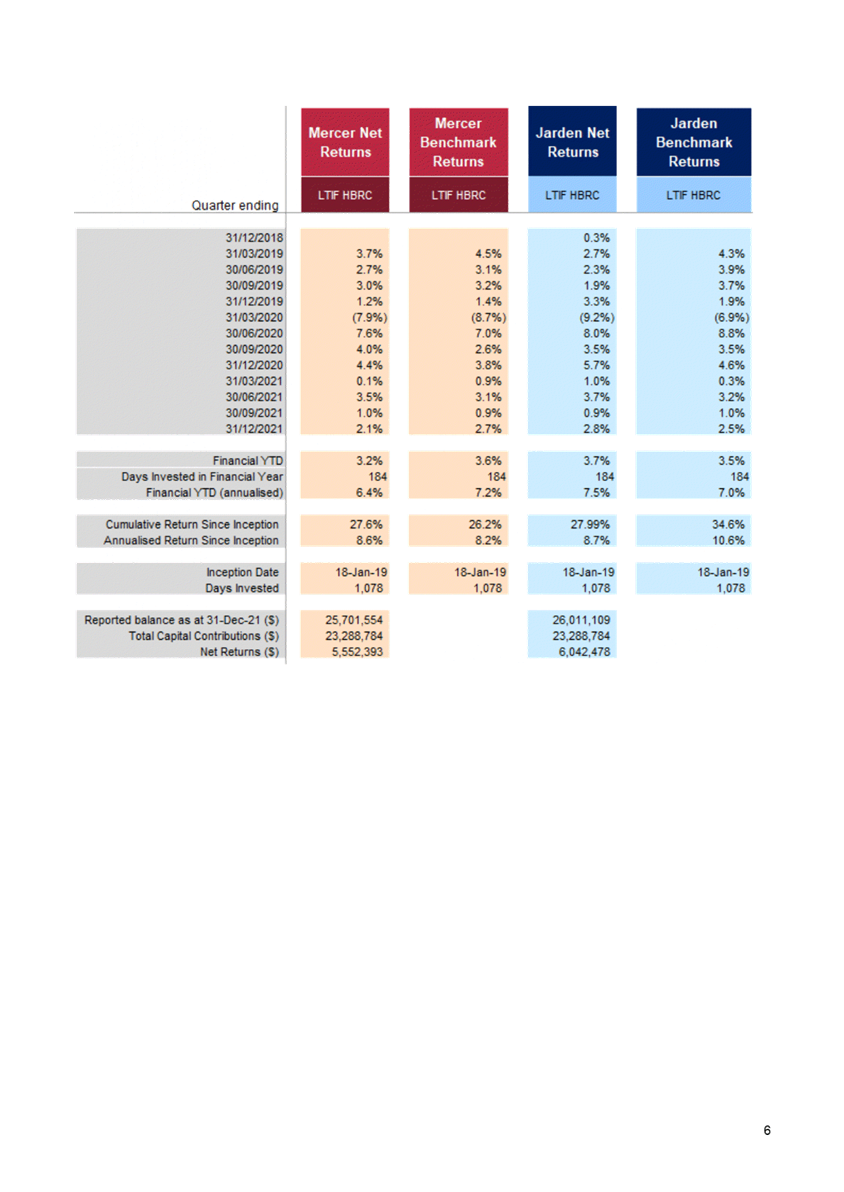


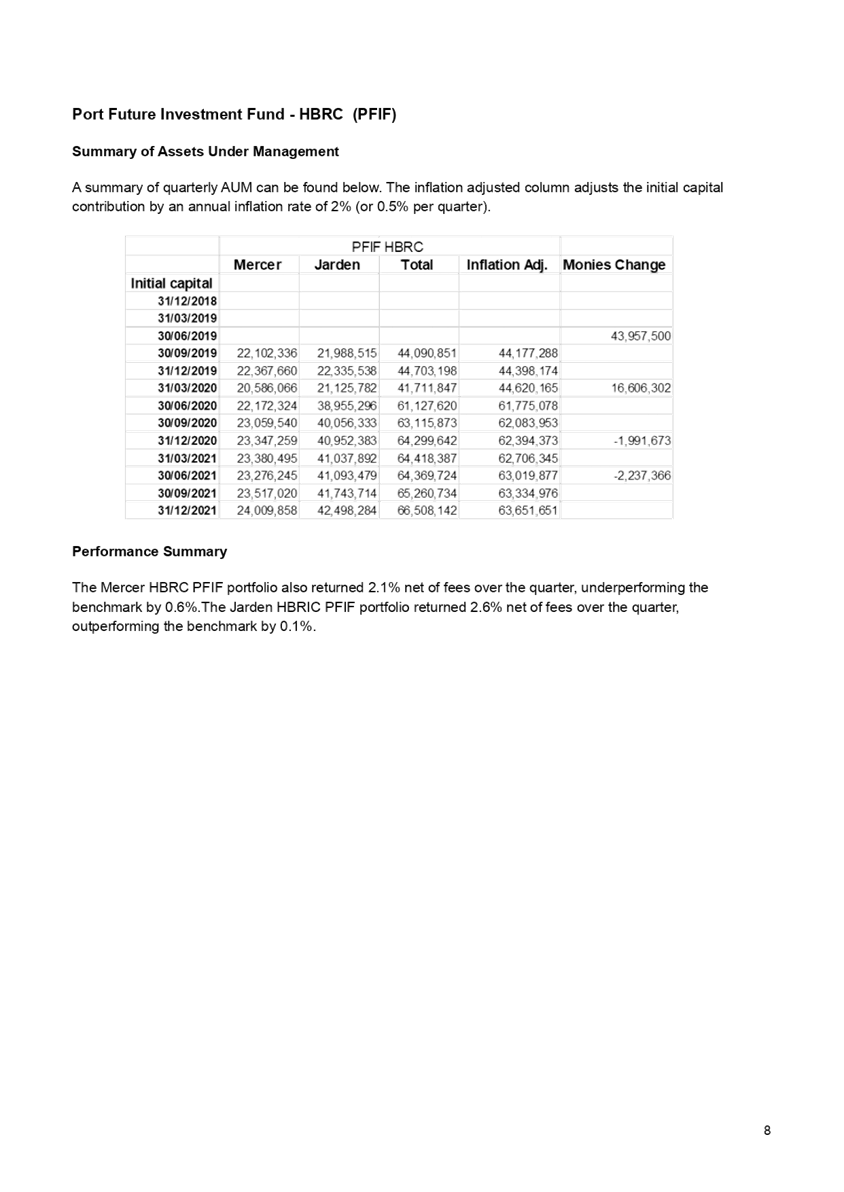
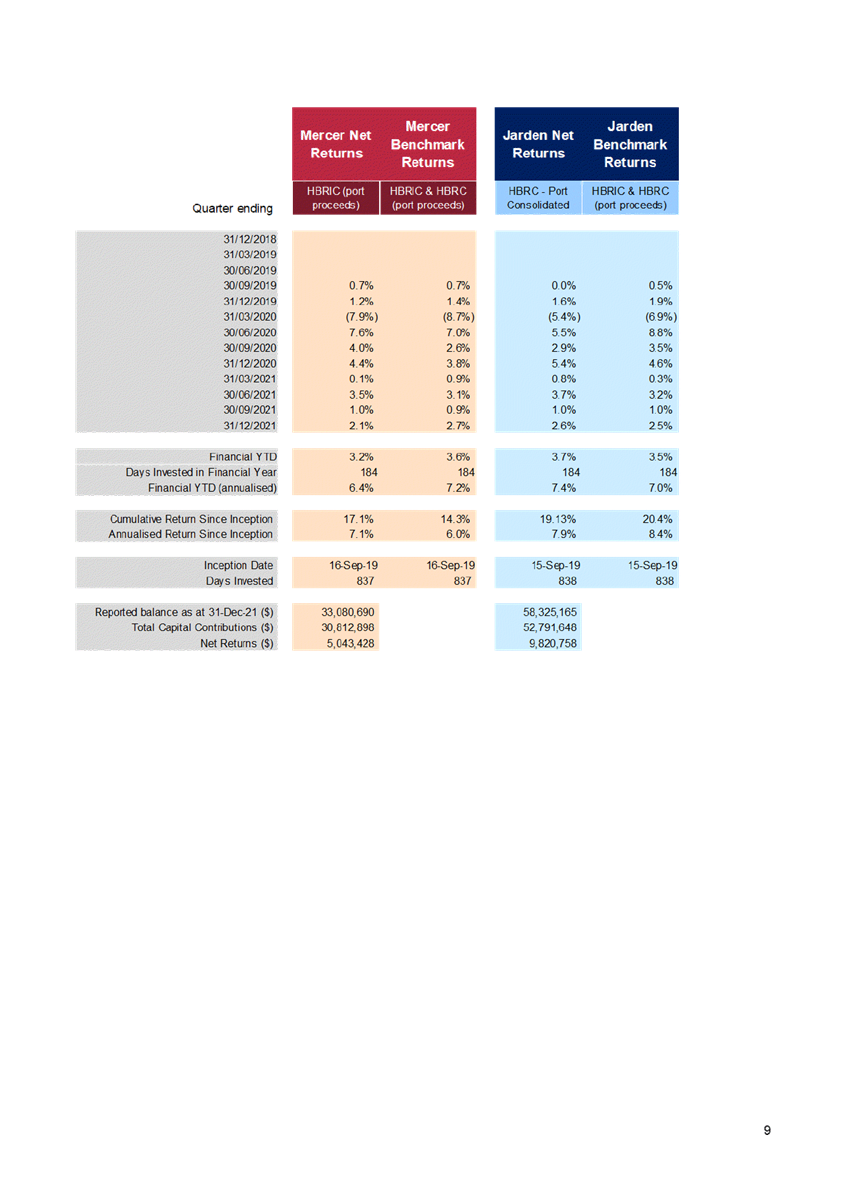





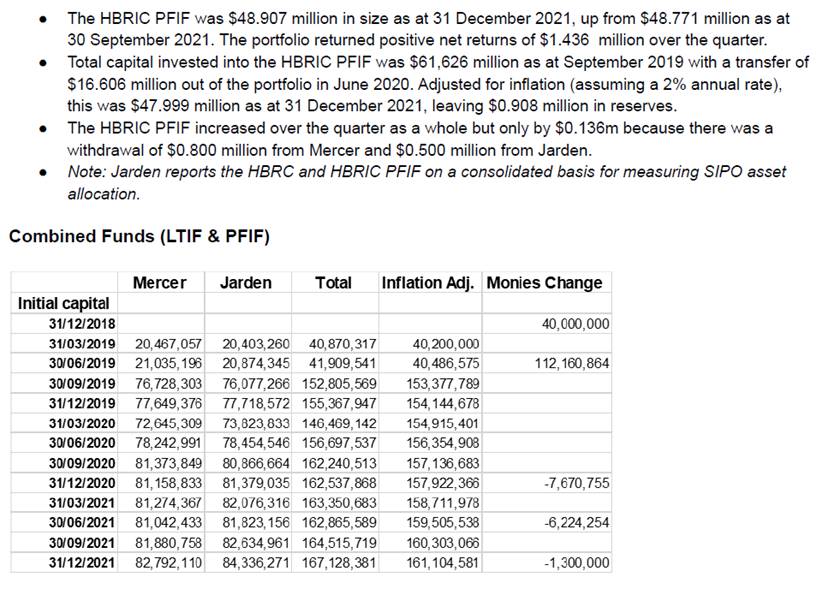
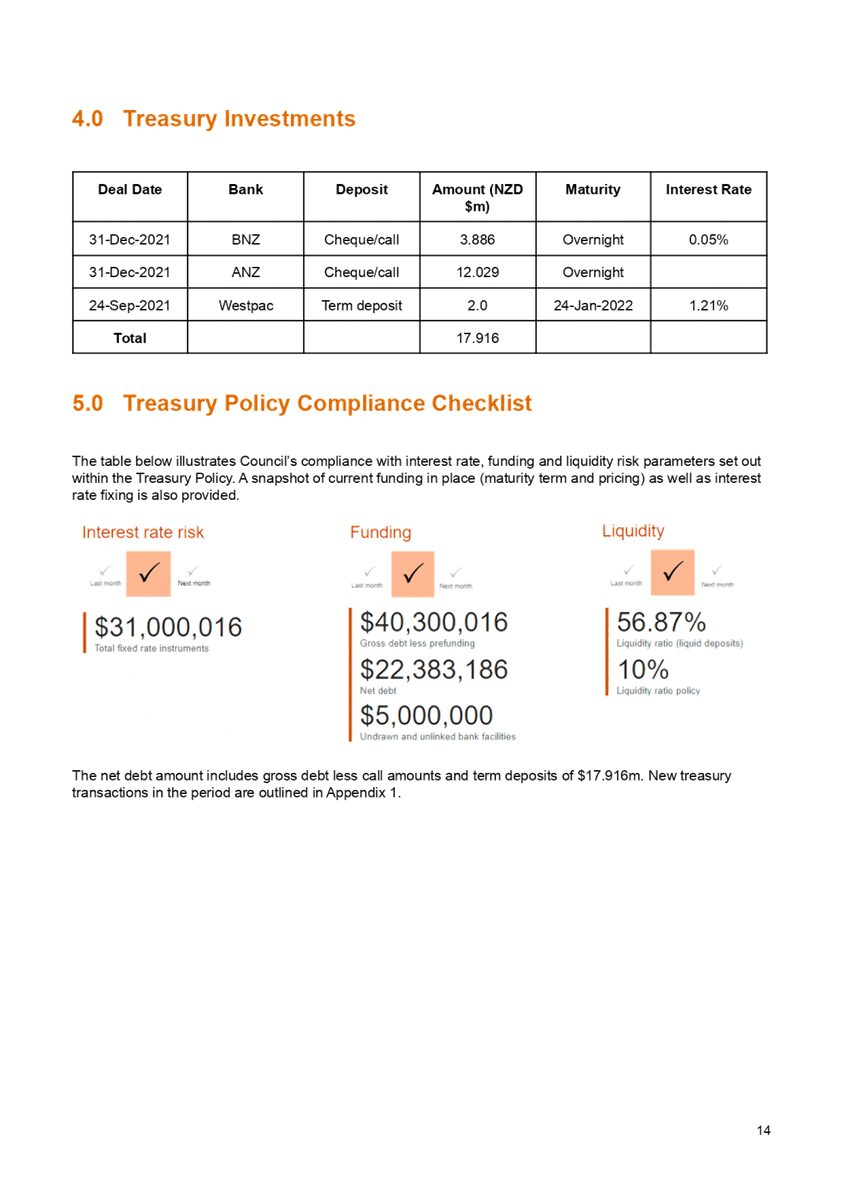

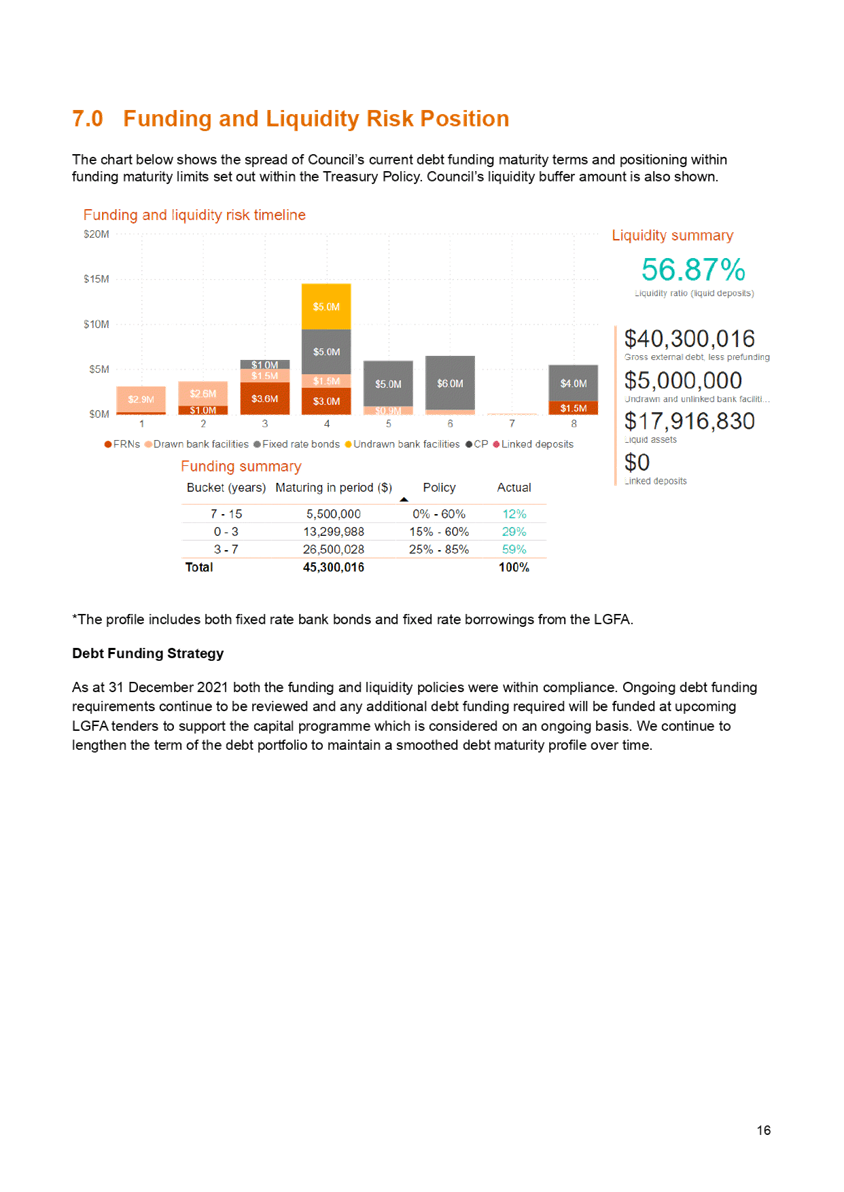

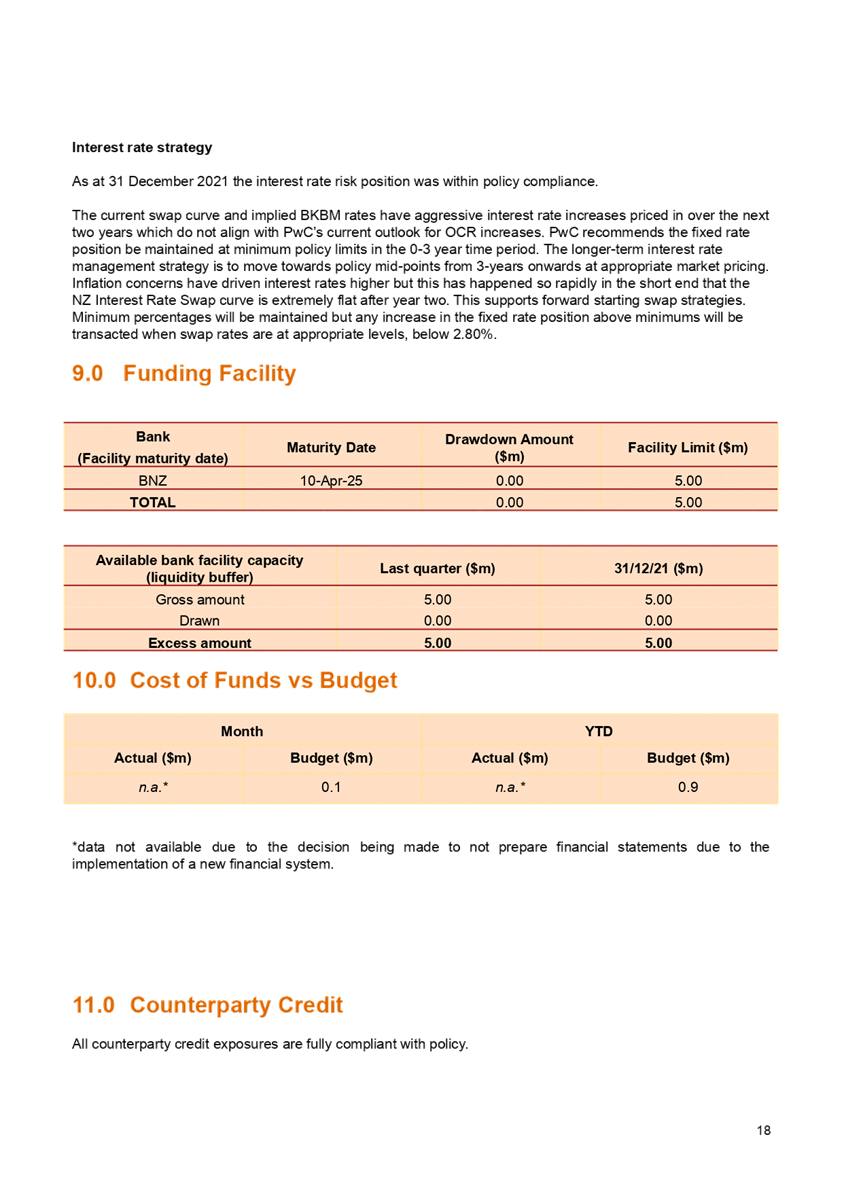
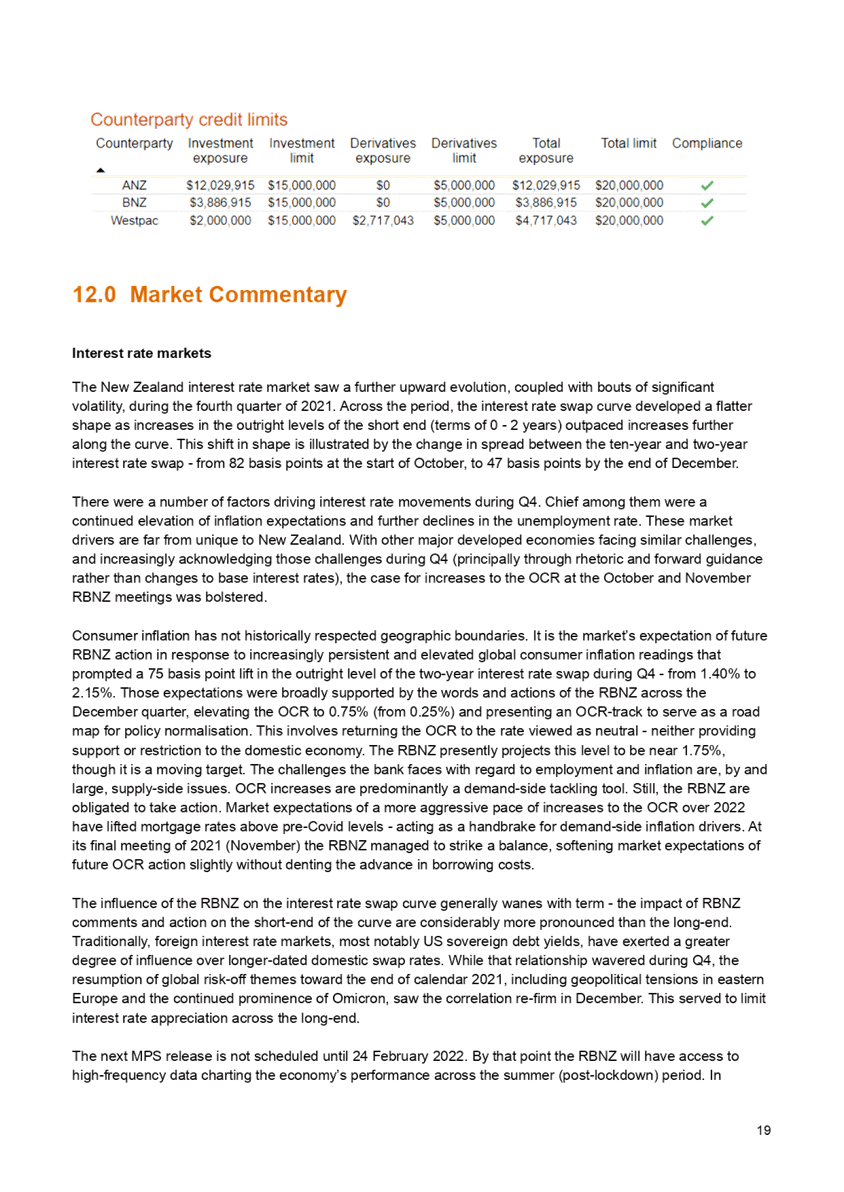
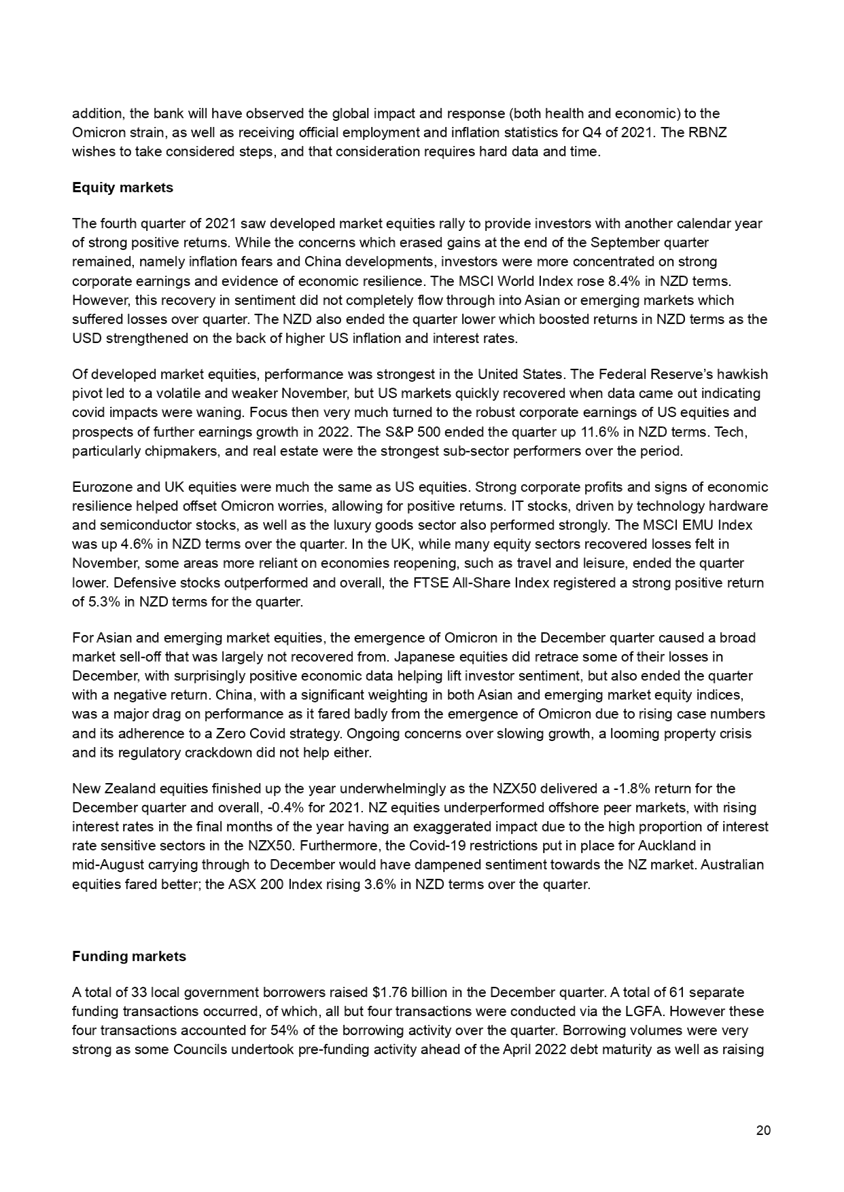



HAWKE’S BAY REGIONAL
COUNCIL
Finance
Audit & Risk Sub-committee
02 March
2022
Subject: HBRC Forestry Update
Reason for Report
1. This paper provides a
summary of Hawke’s Bay Regional Council’s (HBRC) forestry assets as
requested by Finance, Audit and Risk Sub-committee (FARS) on 15 December
2021.
2. The last comprehensive
update on HBRC’s forest assets was presented to Corporate and Strategic
Committee, 23 September 2015 after request by the Committee for a paper “…establishing
values other than commercial that demonstrate the justification for Council
maintaining this investment and projecting the ongoing forest management
programme beyond 10 years to cover the rotation period of the range of
species.”
Executive Summary
3. Local authorities own or
manage 53,282 hectares (ha) of forest land in New Zealand (Attached).
4. HBRC manages the 550ha
Crown-owned Tangoio Soil Conservation Reserve as required by section 16 of the
Soil Conservation and Rivers Control Act (1941). 58% (320ha) of the Reserve is
currently in commercial forestry and the remainder in native forest at varying
stages of regeneration. Commercial forest in the Reserve has a 30 June 2021
valuation of $6,214,000 (Attached).
5. In addition, there are
529ha of commercial forestry across five HBRC-owned properties of a combined
area of 1029ha. These properties have a range of objectives as will be
described in this item and which include wastewater irrigation, carbon
sequestration, recreation, and trialling and demonstrating alternative timber
species. Commercial forest in the HBRC properties has a 30 June 2021 valuation
of $7,754,800.
6. Around 24ha of commercial
forest has been established on river land controlled by HBRC. This is currently
unvalued.
7. HBRC is a minor partner in
190ha of erosion-control forests across the region. These are expected to
return in the realm of $500,000 to HBRC over the coming 10 years.
8. HBRC has a
significant carbon portfolio of 146,400 post 89 NZU and 14,907 pre 1990 NZU,
currently worth $13 million at the current price of $82.
9. Detailed
management plans are in place for the Tangoio Soil Conservation Reserve and the
HBRC Forest Estate and have been approved by two trained foresters, one a
member of the New Zealand Institute of Forestry. The Maungaharuru Tangitū
Trust has approved the management plan for the Tangoio Soil Conservation
Reserve as is required by the Mana Enhancing Agreement signed with HBRC in
2016. Objectives and policies from the plans have been provided in this item
and full plans will be provided to Councillors on request.
Strategic Fit
Water quality safety and
certainty
10. All of the forests provide
erosion control and sediment reduction benefits to some extent, but in the
Waipukurau and Waipawa Forests this is negligible as the land is very stable
anyway. In the erosion-prone soils of Tūtira,
Waihapua and Tangoio, the benefits are significant. Having replaced the network of aging
septic tanks with a more sustainable option, the Mahia Forest plays an
important role in improving water quality and safety in that area.
Smart sustainable landuse
11. The HBRC Forests are all
multi-use properties. As well as the financial returns they generate via carbon
sequestration and log sales, they play important roles in the communities in
which they are situated.
Healthy and functioning biodiversity
12. The Tangoio Soil
Conservation Reserve and Mahia Forest contain areas classified by HBRC’s
ecologists as ecosystem prioritisation sites. Significant areas of native are
being planted and regenerated in the Tūtira and Waipukurau Forests, and
the Tangoio Soil Conservation Reserve over the coming years.
Sustainable
services and infrastructure.
13. The Mahia
Forest provides an important wastewater treatment function to the Mahia
Community, and the Waipukurau Forest (also known as Gum Trees Mountain Bike
Park) is a popular recreational venue and attraction to the town. Management of
the Tangoio Soil Conservation Reserve is very important in ensuring the ongoing
integrity of the section of State Highway 2 that runs through it. Due to access
limitations, the Waihapua Forest Park has not yet been developed, but there is
strong support for this in the surrounding Tūtira Community as represented by the now
disbanded ‘Tūtira Visionary Group’.
Background
Tangoio Soil Conservation Reserve
14. The Tangoio Soil
Conservation Reserve comprises 550ha adjacent to State Highway 2 between
Tangoio and Tūtira, acquired by the Crown in 1946 for the protection of
the Highway, following ongoing closures due to slips, most notably the
‘Anzac Storm’ of 1938 which caused the Highway to be closed for a
period of months.
15. The Reserve was managed in
turn by a series of Government departments, before this responsibility passed
to the Hawke’s Bay Catchment Board and then its successor HBRC in 1989 as
required by Section 16 of the Act:
15.1. “Every
soil conservation reserve shall be under the control and management of the Board within
whose district it is situated, and the Board
shall manage and control the reserve in such manner as in its opinion will best
conserve the soil of the reserve and prevent injury to other land.”
16. Currently, 58% of the
Reserve’s area (320ha) is in commercial forestry and the remainder in
varying stages of reversion to native forest. Returns from the commercial
forestry are held in a Reserve Fund, which is used to entirely fund the
management of the Reserve - no ratepayer funds are used in the management of
the Reserve.
17. Budgets are reviewed every
3 years and cashflows modelled over 40 years to ensure the ongoing
sustainability of the Reserve Fund. As required by Sections 21-23 of the
Maungaharuru Tangitū Hapū Claims Settlement Act (2014), surplus funds
not required for Reserve management are transferred to a ‘Catchments
Fund’ where they available for carrying out soil conservation projects in
the surrounding catchments in partnership with the Maungaharuru Tangitū
Trust (MTT).
18. To date, $320,000 of
Reserve Funds have helped leverage some $6 million in funding for the MTT-led
projects Tūtira
Mai Ngā Iwi, Te
Waiū o Tūtira, and Kia eke Te Ngārue, Kia eke Arapawanui.
19. A Mana Enhancing Agreement
signed with MTT in 2016 requires HBRC to maximise training and employment
opportunities for MTT in the Reserve, and for HBRC and MTT to agree the
Reserve’s three-yearly management plans.
20. As the forests on the
Reserve were established prior to 1990, they are not eligible for entry in the
Emissions Trading Scheme and earning NZU.
Forests
owned by HBRC
River Berms
21. Around 24ha of forest is
planted on river berms around the region. Generally, soils are very stony and
conditions for tree growth are poor in these sites. River berms are also
invariably weed hot spots and control of these in newly established plantings
can be challenging.
22. Despite these challenges,
forests are a good use for the many unused hectares of river berm land
controlled by HBRC. As well as the revenue from carbon and logs, tree canopies
assist in shading out the various weeds over time and negate the need for
grazing and the associated risks of nutrient loss in the free-draining gravel
soils. The flat terrain ensures low logging costs with no tracking and
subsequently low risk of sediment loss.
23. 6ha of the river berm
forests are radiata pine established in the mid to late 1990’s. The other
18ha is a 2021 planting of radiata pine (14ha) and eucalyptus bosistoana (4ha)
on the left bank of the Waipawa River off Walker Road.
24. While the Walker Road
planting is too newly established for registration in the emissions trading
scheme, HBRC’s extensive willow plantings received a one-off allocation
of 14,907 pre-1990 NZU in 2008.
Joint
Venture Forests
25. Between 1994 and 2000, HBRC
entered into 10 joint ventures with landowners across the region to establish
radiata pine plantations on some 190 hectares of erosion-prone land. The joint
venture contracts expire on harvest of the trees or expiry of the 35-year term.
|
Owner
|
YOE
|
Logging Date (at 30yrs)
|
Ha
|
Estimated Ha Harvestable
|
HBRC share
|
Estimated HBRC revenue
|
|
Netherton Station
|
1995
|
2025
|
29
|
14
|
14%
|
$35,000
|
|
McRae Trust
|
1995
|
2025
|
9.5
|
9.5
|
13%
|
$30,875
|
|
Roy Stoddart
|
1995
|
2025
|
40
|
4
|
15%
|
$
-
|
|
Parsons Estate
|
1996
|
2026
|
22.6
|
22.6
|
22.6%
|
$127,690
|
|
Beamish
|
1996
|
-
|
5.4
|
0
|
18%
|
$
-
|
|
Waipari Station (Kairākau)
|
1997
|
2027
|
20
|
20
|
16.6%
|
$83,000
|
|
Lloyd and Virginia Cave
|
1997
|
2027
|
30
|
30
|
13%
|
$97,500
|
|
Bruce Goldstone
|
2000
|
2030
|
4.5
|
4.5
|
13%
|
$14,625
|
|
Waipari Station (Glengarry)
|
2000
|
2030
|
20
|
20
|
14%
|
$70,000
|
|
Haupouri Station
|
2000
|
_
|
8.4
|
0
|
18%
|
$
-
|
|
Totals
|
189.4
|
124.6
|
|
$535,385
|
Table
1: HBRC Joint Venture Erosion Control Forests
26. Though erosion control was
HBRC’s primary objective, the agreements anticipated the forests would
eventually be harvested and generate a financial return. The objective of the
joint venture contracts is stated in Clause 1.1 of each:
26.1. “The goal of the
parties hereto is the establishment and management of the Erosion Control
Plantation, which is to be planted with rapidly growing exotic timber species,
for a rotation period to ensure that the land within the Erosion Control
Plantation is managed and harvested in a manner which will minimise the erosion
impacts”.
27. More recently, staff have
agreed with landowners that approximately 64ha of the joint ventures will not
be harvested as the environmental impacts would be too great. Staff are looking
into ways to use some of the revenue from harvesting the better joint venture
forests to help revert the unharvested forests to native over time.
28. Management objectives for
the joint venture forests are listed in the HBRC Forest Estate
2021-2031 Management Plan as:
28.1. To ensure where harvest is
environmentally and economically feasible, it is carried out with minimal soil
conservation or environmental impacts
28.2. To assist landowners in
transitioning harvested sites to a sustainable post-harvest landuse
28.3. To assist landowners to
transition to permanent native forest where harvest is not environmentally or
economically feasible
28.4. To maximise financial
returns from the forests without compromising the above objectives.
Tūtira
Regional Park
29. 78ha of pine forest was
established on the Tūtira Regional Park between 1991-1993, prior to HBRC
purchasing the property, and a further 36ha immediately after. All were
established primarily for soil conservation following the devastation wreaked
by Cyclone Bola (Attached), with eventual financial returns from harvest being
an important secondary objective.
30. The forest is currently in
the process of being harvested and afterwards approximately 50% will be
converted to native forest for permanent retirement. Council papers relating to
the harvest procurement process were presented to EICC on 19 June 2019 and
regarding the replanting on 3 February 2021.
31. The Tūtira mānuka
plantation is not considered in this item and is described fully as a separate
item in this agenda.
32. Management objectives for
the Tūtira Forest are listed in the 2021-2031
HBRC Forest Estate Management Plan as:
32.1. To manage the forest and
plantation in a way that best supports the soil conservation, biodiversity,
recreational, cultural and aesthetic values of the Regional Park
32.2. To maximise soil
conservation and minimise sediment loss to waterways and Lakes Tūtira and
Waikōpiro
32.3. To facilitate reversion to
native forest over time
32.4. To enhance biodiversity
values on the property and create connections to other habitat in the District.
32.5. To maximise financial
returns from the Forest while not compromising any of the above.
Waihapua Forest Park
33. The Waihapua property had
been of interest to HBRC for many years before the opportunity to purchase it
arose in 2009. The reasons were summarised by a sub-committee of Council
charged with forming a strategy statement for the property in the same year:
33.1. “It’s
significant open space and strategic value given its location adjacent to key
amenity areas and Tangoio Soil Conservation Reserve; its potential to
demonstrate land use options relating to soil conservation and waterways; its
severely eroded nature (Attached); and its commercial advantages associated
with timber and carbon trading.”
34. Following purchase, Council
developed the following Goal for the property:
34.1. “A profitable
working example of integrated and multi-functional land use centred on sequestration
and soil conservation forestry consistent with wider social, amenity,
environmental and economic values and opportunities within the Tutira
area.”
35. Council also identified key
functions for the property as:
35.1. ‘social engagement,
amenity values, recreation, the improvement of water quality, soil
conservation, biodiversity and indigenous ecological values, research, and
demonstration.”
36. Council was advised at the
time an internal rate of return of 6-7% was likely.
37. The name ‘Waihapua
Forest Park’ was formally adopted by Council on 27 April 2011 after
advice from Maungaharuru Tangitū Trust, endorsed by the Tūtira
Visionary Group- a group formed around that time to encourage the development
of tourism and other opportunities for the Tūtira District. The name is
derived from a deep spring with special qualities found on the property.
38. Planting was planned in
conjunction with the Hawke’s Bay Branch of the New Zealand Farm Forestry
Association and carried out between 2009 and 2013. More than twenty-five timber
species on a range of management regimes were established (Attached). There are
two dedicated trial sites on the property, one of eucalyptus fastigata, and the
other of mixed ground durable eucalyptus species. The site-specific planting
resulted in many small compartments, useful for trial and demonstration
purposes, but significantly increasing the difficulty of logging economically
using conventional methods.
39. Approximately 30ha of the
property was deemed to be too steep and erosion-prone to establish in
production forestry or was already in the early stages of reversion to native
forest and not planted with production species on that basis.
40. As well as being envisaged
as a future recreational and educational venue in its own right, Waihapua was
seen as a key addition to a potential walkway over the corridor of public lands
stretching almost uninterrupted for some 16km from the bottom of the Tangoio
Soil Conservation Reserve In the south to the top of the Tūtira Regional
Park in the north (figure 1 below).
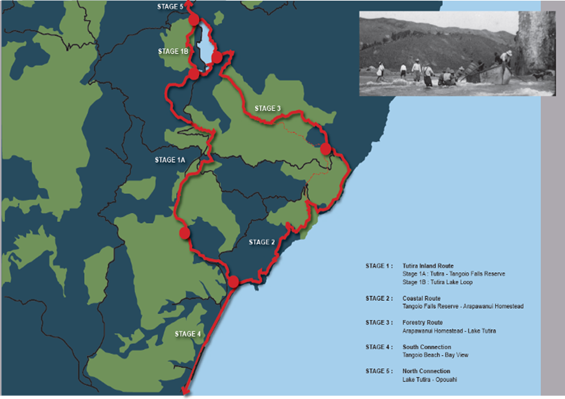
Figure 1: Concept Plan,
Tūtira Trails
41. Due to a lack of safe
access to the property, it has not yet been developed and opened to the public.
The main access is through private property, but the easement only provides for
HBRC and its contractors. Other options are possible, but difficult to form
tracks in given the steep and eroding nature of the land. Access from State
Highway 2 is hazardous and would require investment before opening to the
public.
42. Management objectives are
listed in the HBRC Forest Estate 2021-2031 Management Plan as:
42.1. To maintain soil
conservation on the property and minimise sediment loss to the Waikoau River
and erosion impacts on State Highway 2
42.2. To establish and maintain
secure access to the property for recreational use
42.3. To establish and maintain
links from the property to Guthrie-Smith Arboretum and Education Trust and
Tūtira Regional Park
42.4. To enhance biodiversity
values on the property, creating connections to other habitat in the District
42.5. To demonstrate alternative
commercial forest species and support the development of their genetics and
markets
42.6. To maximise financial
returns from the Forest while not compromising any of the above.
Mahia
Forest
43. The Mahia Forest property
was purchased in 2009 primarily as a receiving environment for Mahia
township’s treated wastewater, but also as a carbon and timber investment
property.
44. Unlike the Central
Hawke’s Bay Wastewater Forests, Wairoa District Council (WDC) did proceed
with irrigating treated wastewater into the Mahia Forest.
45. After being pumped over the
hill from the township, the wastewater passes through a series of three
settlement ponds, before being screened and pumped to irrigation fields in the
forest. Irrigation in the different fields is alternated to allow them to fully
dry out between applications and maintain the treatment capacity of the soils.
Of the total 50ha land area, and 35ha forested area, approximately 11ha are
used to treat wastewater.
46. A key risk in
wastewater-irrigated forests is exceeding the treatment capacity of the soil.
This was a major reason for the dissolution of Rotorua’s Whakarewarewa
Forest wastewater irrigation scheme after 28 years of operation. This risk is
managed in the Mahia Forest through ongoing monitoring of tree health,
application volumes and soil moisture levels. The risk to the environment
is managed by monitoring water quality parameters in the stream leaving the
forest.

Figure 2: Nitrogen removed from
Wastewater in the Whakarewarewa Land Treatment System Over Time[2]
47. Management objectives are
listed in the HBRC Forest Estate 2021-2031 Management Plan as:
47.1. To maintain the ability of
the Land to receive and effectively treat wastewater from the Mahia Township
for the foreseeable future
47.2. To protect cultural values
within the Forest, and in particular the registered archaeological sites
47.3. To enhance biodiversity
values in the Forest, building on the work of the Predator Free Mahia Project
47.4. To maximise financial
returns from the Forest while not compromising any of the above.
Central
Hawke’s Bay Forests: Waipukurau and Waipawa
48. The two Central
Hawke’s Bay properties were purchased between 2009 – 2010 and, as
with the Mahia Forest, were established in forest for the purpose of safely
disposing of treated wastewater from the townships while earning revenue from
carbon sequestration and ‘high value hardwood timber’.
49. Central Hawke’s Bay
District Council opted for another option to deal with their wastewater, and
the forests have never been used for this purpose.
50. In 2009 HBRC signed an MOU
with the Rotary Rivers Pathway Trust, allowing the Trust use of the Waipukurau
Forest for mountain biking for a term of 30 years. Since that time, the Trust
has established approximately 15km of mountain bike tracks in the forest, with
a further 5km scheduled for completion in the coming months. The Park is ridden
an estimated 10,000 times annually.
51. Currently, the Waipawa
Forest has only a commercial purpose, though two requests from the community
have been made for its use. The Central Hawkes Bay District Council has
requested the use of the forest for disposing of sludge remaining after their
sewerage treatment, and the Hawkes Bay Riders’ Club has requested its use
for horse rides and potentially grazing.
52. Management objectives for
the Central Hawkes Bay Forests are listed in the HBRC Forest Estate 2021-2031
Management Plan as:
52.1. To maintain the ability of
the Land to receive and effectively treat Central Hawkes Bay wastewater if
required
52.2. To maintain the
recreational value of the Waipukurau Forest to the Central Hawkes Bay Community
52.3. To enhance biodiversity
values in the Waipukurau, creating connections to habitat along the Tukituki
River
52.4. To maximise financial
returns from the Forests while not compromising any of the above.
Management
53. Currently, management of
the Tangoio Soil Conservation Reserve and HBRC Forests is carried out by a
Forests and Reserves Officer, in the Open Spaces Team of the Asset Management
Group of HBRC.
54. Forest management decisions
are made according to HBRC’s standard financial delegations and
significance criteria. Detailed management plans for the Tangoio Soil
Conservation Reserve and HBRC Forests align with the LTP period and set out
forest objectives and policies. The plans have been reviewed and approved by
two reputable Hawke ‘s Bay foresters as well as the Team Leader Open
Spaces and Group Manager, Asset Management.
55. Due to the high complexity
of HBRC’s carbon portfolio and the significant costs of calculation
errors (both in terms of fines and impacts on decisions), carbon accounting is
still contracted to an external consultant. Similarly, harvest in sensitive
environments is contracted to harvest managers.
56. A position of both forestry
regulator and manager puts HBRC in an unusual situation and entails risks of
the regulator being held to account for its own practices, a risk that is
greater than that of many other local authorities given the erosion prone and
environmentally sensitive nature of a large area of its forests. However, this
is not an unreasonable expectation and helps HBRC to keep skin in the game of
forestry, form solid working relationships with industry, and sustain expertise
within the organisation in making decisions and advising on matters relating to
forestry.
Discussion
Key Issues
Alternative species
57. HBRC forests contain a wide
range of species as shown in Figure 3 below. Though generally alternative
species don’t provide the certainty or level of harvest returns of radiata
pine, in some situations, other priorities such as aesthetic value and carbon
sequestration have taken precedence. Past replanting decisions, particularly at
Waihapua, also reflect Council’s desire to support species
diversification within the New Zealand Forest Industry.
|

|

|
|
Figure 3:
Species mix in TSCR (left) and HBRC Forests (right)
|
58. The current HBRC Forest
Estate Management Plan species selection policy attempts to balance these
objectives with managing risk in the returns on investment of ratepayer funds
(particularly given the increasing area returning to native) by maintaining radiata
pine at around 50% of the commercial area of the estate with the remainder
allocated to alternative species. Given the importance of maintaining the
sustainability of the TSCR reserve fund and Catchments Fund and the
progressively decreasing area of commercial forest, the species selection
policy there is 75% radiata pine, once again applied to the commercial area
only. This ratio will be revised at the next management plan period (3-yearly
to coincide with the LTP period), particularly given the recent high prices for
some cypress species.
59. The development of
alternative timber species has historically been limited in large part by
limited resources spread widely over a variety of species. Recently, leadership
in projects such as the Specialty Wood Products Partnership (SWPP), New Zealand
Drylands Forest Initiative (NZDFI), and the Cypress Interest Group of the New
Zealand Farm Forestry Association has focused effort and resources more
effectively behind the most promising species.
60. Small volumes of
alternative species have become available for milling recently- eucalyptus
fastigata were situated amongst radiata pine logged at Tangoio, and large
eucalyptus regnans and juglans nigra (black walnut) will be felled soon
in a land clearance exercise, also at Tangoio. In general though, the
alternative species are all young and, particularly as alternative species have
longer rotation ages than radiata pine, no significant volumes will become
available for harvest for at least another 15 years. It is difficult to model
financial returns from alternative species given the small volumes traded and
subsequent lack of market data.
61. Under current market
conditions, the large areas of eucalyptus fastigata and regnans on the HBRC
estate are uneconomic to harvest and are a carbon crop only. Although the
timber able to be effectively processed is of reasonable quality, markets for
the logs are very limited and prices very low. This is mostly due to very poor
recovery of sawn timber from logs (~50%) due to issues with warping, cell
collapse and splitting during and after milling, and the time and handling in
trying to minimise these issues. It is possible markets for these species may
develop in the future as technology in wood biofuels, LVL (laminated veneer lumber),
and CLT (cross laminated timber) develops.
62. Species selection
objectives and policies are listed in the HBRC Forest Estate Management Plan
as:
Objectives
4.9.1 To grow
species appropriate for site and best meeting the Council’s financial and
non- financial forest management
objectives.
4.9.2 To support
well founded species diversification of the New Zealand Forest Estate.
Policy
4.9.3 Select native
species in preference to exotic where they are equally able to achieve the
given management objectives.
4.9.4 Confirm
replanting species selection choices prior to harvest based on the most current
advice and information available and on the criteria of:
4.9.4.1 Alignment
with primary management objective of the land, ie either erosion control or
wastewater treatment, and secondarily recreational access.
4.9.4.2 Site
suitability.
4.9.4.3 Financial
returns on investment.
4.9.4.4 Contribution
to regional economy (regional processing opportunities).
4.9.4.5 Aesthetics
(in high public use areas).
4.9.4.6 Strategic
alignment with industry initiatives and HBRC goals
Carbon
forests and carbon trading
63. Carbon farming was a
significant factor in the purchase of the Waihapua, Mahia, Waipukurau and
Waipawa Forests and the decision to plant large areas of fast-growing
eucalyptus species in them. Apart from the highest erosion susceptibility land
at Waihapua, they weren’t envisaged as being permanent forests, and
timber production was listed as a complementary objective, though as described
previously this will be difficult to achieve.
64. The NZU balance earned in
the forests to date and modelled into the future is shown in figure 4 below. The dotted line indicates the decreasing accuracy in
predicting NZU balances at extended timelines. At the current historic
high of $82 per NZU, the balance of 146,400 post 89
NZU and 14,907 pre 1990 NZU is currently worth $13 million.
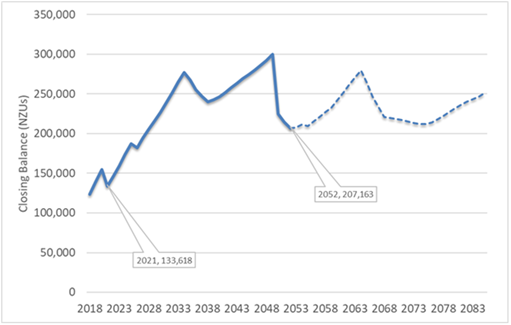
Figure 4: Forecast HBRC NZU balance to
2083
65. While HBRC will trade NZU
for the first time in the near future to address climate change related issues
(to fund a Climate Change Ambassador role and address forest health issues in
HBRC’s Central Hawke’s Bay forests), HBRC does not currently have a
carbon trading policy.
Central
Hawke’s Bay eucalyptus regnans
66. Large areas of eucalyptus
regnans (approximately 75ha) were planted in the establishment of the Central
Hawke’s Bay forests. As a rapidly growing species, e. regnans takes in
large volumes of water and nutrients and is well-suited to wastewater
irrigation. In addition, stands of healthy e. regnans hold more carbon than any
other forest type in the world making them well suited to carbon
forestry.
67. However, without irrigation
e. regnans isn’t a suitable species for the CHB climate. The
rainfall band in it’s natural range in Tasmania and southern Victoria is
900-1100mm[3],
whereas the five year average for Waipukurau is 690mm, with recent lows of
550mm in 2019 and 530mm in 2020.
68. Approximately 3.5ha (8%) of
the e. regnans in the Waipukurau Forest and 2ha (5%) of the e. regnans in the
Waipawa Forest died in the 2019-2020 and 2020 -2021 summer droughts. Tree
mortality was worst in areas with northern aspects and the poorest soils. These
areas have been cleared for replanting in more suitable species, but
particularly given the predicted impacts of climate change, more deaths are
likely in the future.
69. There are no markets for
the trees at this age. Due to their size, a lot of manual handling is involved
in processing and carting them for firewood. Firewood merchants these days
prefer large diameter logs processed using automated machinery, allowing many m3
of wood to be carted and processed efficiently and with little manual
labour.
70. A minimum age of 40 years
is generally recommended before e. regnans can be sold and milled for timber,
in order to better deal with the growth stresses, splitting and warping the
species is prone to. Even then, markets for the trees are very limited and if
they can be found at all they pay poorly, as described previously.
71. In addition, fire risk in
the properties is significant. The e. regnans and other eucalyptus species in
the forest are all of high flammability, and even the radiata pine is classed as
moderate in this regard. Land on the western boundary of the Waipukurau
Forest, in the direction of greatest risk due to the prevailing wind, has been
subdivided and is being sold in lifestyle blocks, and the risk of fires being
started from human actvity and migrating into the property from these
properties will increase.
72. The replanting plan for the
Waipawa Forest is on hold pending a decision on whether HBRC is going to retain
the property or not. If the property is to be sold, staff recommend leaving the
cleared areas unplanted given purchasers may not want those areas back in
forest. If the property is retained and Council agrees to CHBDC’s request
to dispose of biosolids on it, the replanting plan will need to be made with
that in mind.
73. Members of the NZ Farm
Forestry Association and the Rotary Rivers Pathway Trust (the organisation that
has established the mountain bike tracks in the forest) were involved in
planning the replanting of the Waipukurau Forest cleared areas. The plan is
still being confirmed, but key principles at this point are:
73.1. Radiata pine isn’t
the best fit with the recreational values of the forest. Aesthetically, there
are better options, and the harvest regime for radiata pine would require
largely destroying the approximately $300,000 investment in mountain bike
tracks every thirty (30) years. Planting species able to be logged selectively
and milled in small local or portable mills for niche markets would minimise
this damage and disruption to the recreational use of the property. As the
forest is generally easy rolling contour, this method of harvest will be easily
achievable.
73.2. Deciduous trees and
broad-leaved natives are far less flammable than exotic conifers due to the
volumes of water they hold in their leaves and stems over summer periods, and
in the Waipukurau Forest this is an important factor given the issues described
previously. Poplars in particular have proven to slow wildfires in Australia
when planted in dense belts. Oaks are the deciduous species with the most
coordinated support behind their genetic and market development.
73.3. While HBRC already has a
demonstration forest and trials in the higher rainfall environment of Waihapua
(1,267mm 10-year average rainfall), the Waipukurau Forest provides an
opportunity to replicate this in a dryland environment, including the use of
lower flammability species. This is particularly relevant given the predicted
impacts of climate change.
73.4. It is important that native
vegetation is planted in the forest. Many of the eucalyptus trees will never
provide a saleable log and at present are purely a carbon crop. For the
longevity of the forest, there must be adequate native vegetation to take over
before the eucalypts become too large and unmanageable. Native is beginning to
regenerate underneath, but this process is slow due to the low rainfall and
scarcity of native seed sources and needs to be supported. Native plants and
trees would be difficult to establish on the hard bony sites that need
replanting and will be planted more strategically in high amenity areas and in
the wetter valley bottoms.
Access
74. HBRC is dependent on access
across private land for entry to the Mahia and Waihapua Forests, and for log
truck access to the Tūtira Forest, and for access to three areas of the
Tangoio Soil Conservation Reserve. Only one of these access points is not
protected by easement.
75. To log the trees in the
Tangoio Soil Conservation Reserve above the Devil’s Elbow, access will
need to be gained across a further three properties. One of these access points
will be a one-off requirement only as the area will not be replanted in
commercial forestry, but easements will be sought for the other two given they
will be replanted in commercial trees.
Waipawa
Forest
76. The only property in the
HBRC portfolio without a clear objective at this point is the Waipawa Forest.
It is currently an underutilised and (given the eucalyptus regnans
issues) a low productivity asset. Given CHBDC’s interest in disposing of
biosolids derived from waste water treatment on the property, a conversation
has been initiated with them regarding the long term future of the site.
Next Steps
77. Review of Waipawa Forest to
be undertaken to determine optimal use of this asset.
78. Develop an approach for a
HBRC carbon trading policy.
Decision Making Process
79. Council and its committees
are required to make every decision in accordance with the requirements of the
Local Government Act 2002 (the Act). Staff have assessed the requirements in relation
to this item and have concluded:
79.1. This agenda item is in
accordance with the Finance, Audit and Risk Sub-committee Terms of Reference,
specifically “The Finance, Audit and Risk
Sub-committee shall have responsibility and authority to (2.4) monitor the performance of Council’s investment
portfolio”.
79.2. As this report is for
information only, the decision making provisions do not apply.
Recommendation
That
the Finance Audit and Risk Sub-committee receives and notes the “HBRC
Forestry Update” staff report.
Authored by:
|
Ben Douglas
Forests and Reserves Officer
|
Russell Engelke
Team Leader Open Spaces
|
Approved by:
|
Chris Dolley
Group Manager Asset Management
|
Jessica Ellerm
Group Manager Corporate Services
|
Attachment/s
|
1⇩
|
Forest assets of New Zealand
Territorial Authorities
|
|
|
|
2⇩
|
HBRC Forests and Tangoio Soil
Conservation Reserve Key Financial Figures
|
|
|
|
3⇩
|
Tutira photo points post-Cyclone
Bola
|
|
|
|
4⇩
|
Waihapua Forest Map
|
|
|
|
5⇩
|
Waihapua photo point 1988 and 2021
|
|
|
|
Forest
assets of New Zealand Territorial Authorities
|
Attachment 1
|
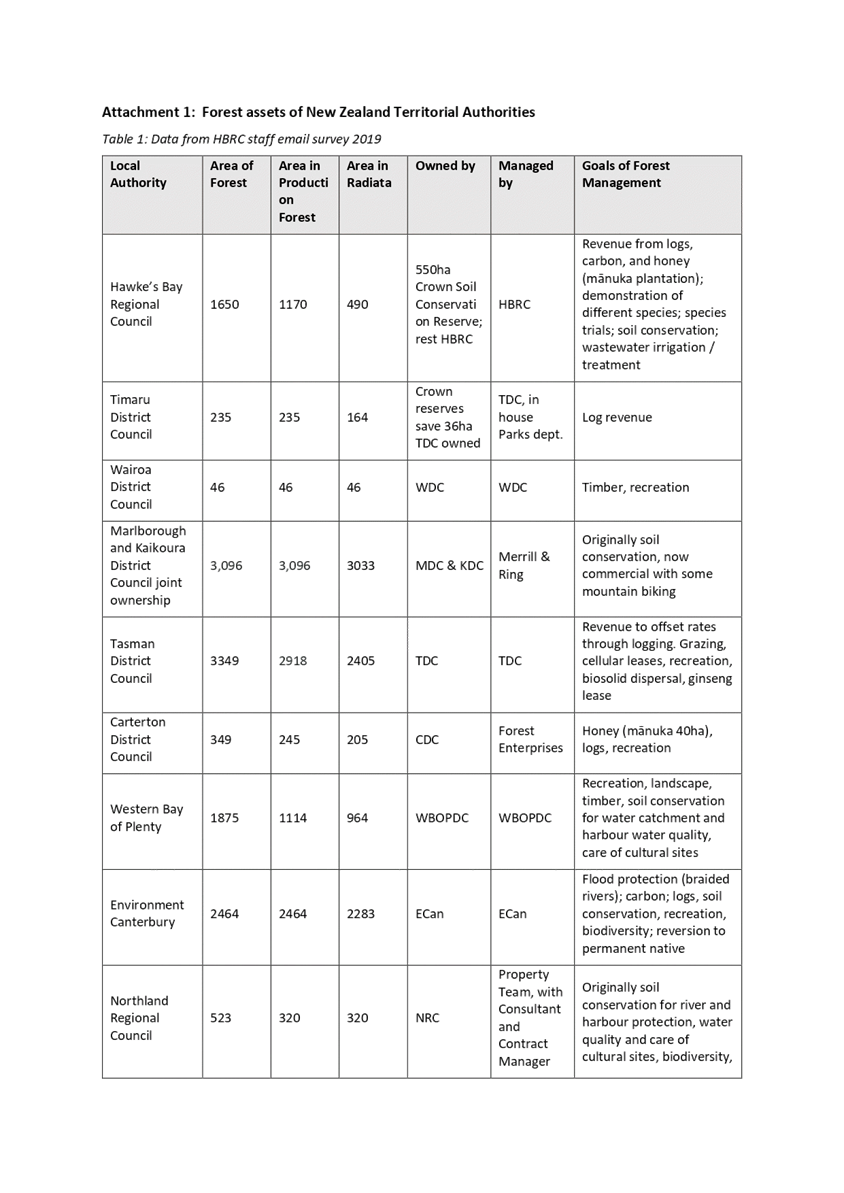

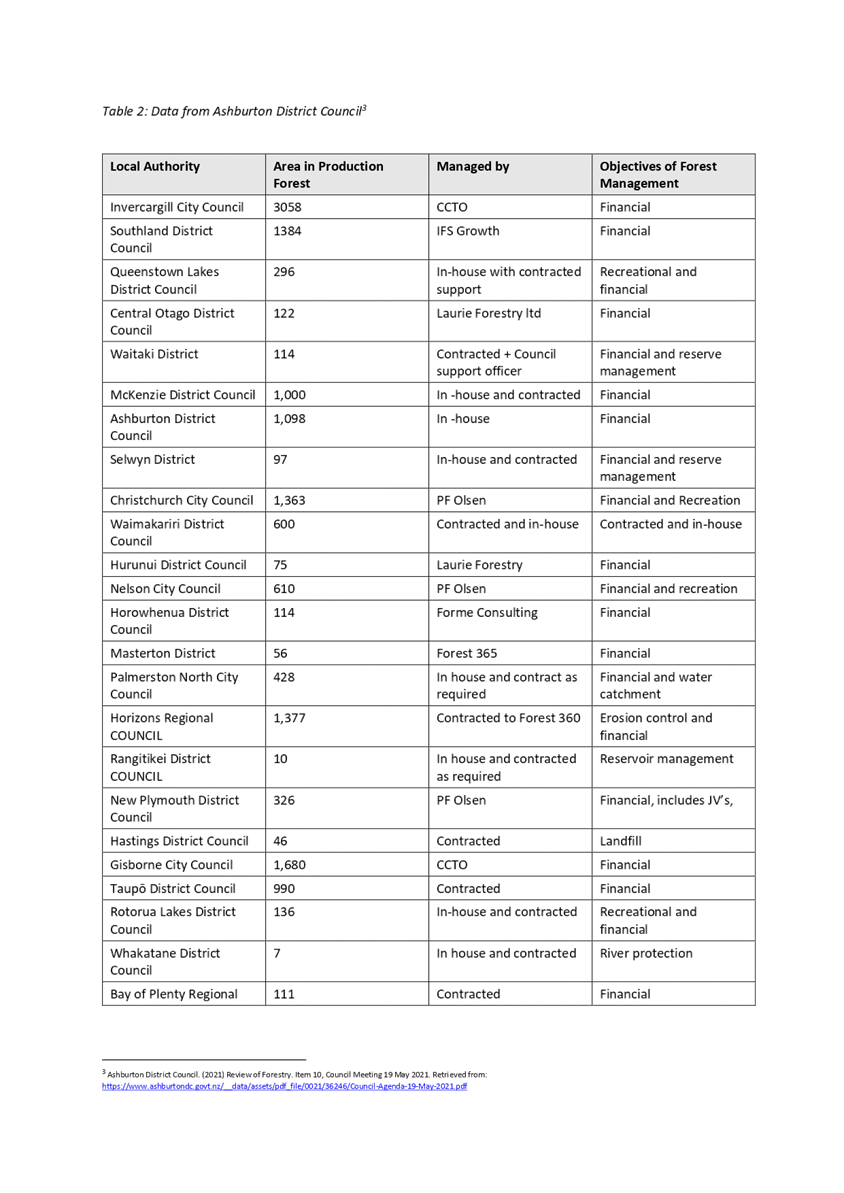
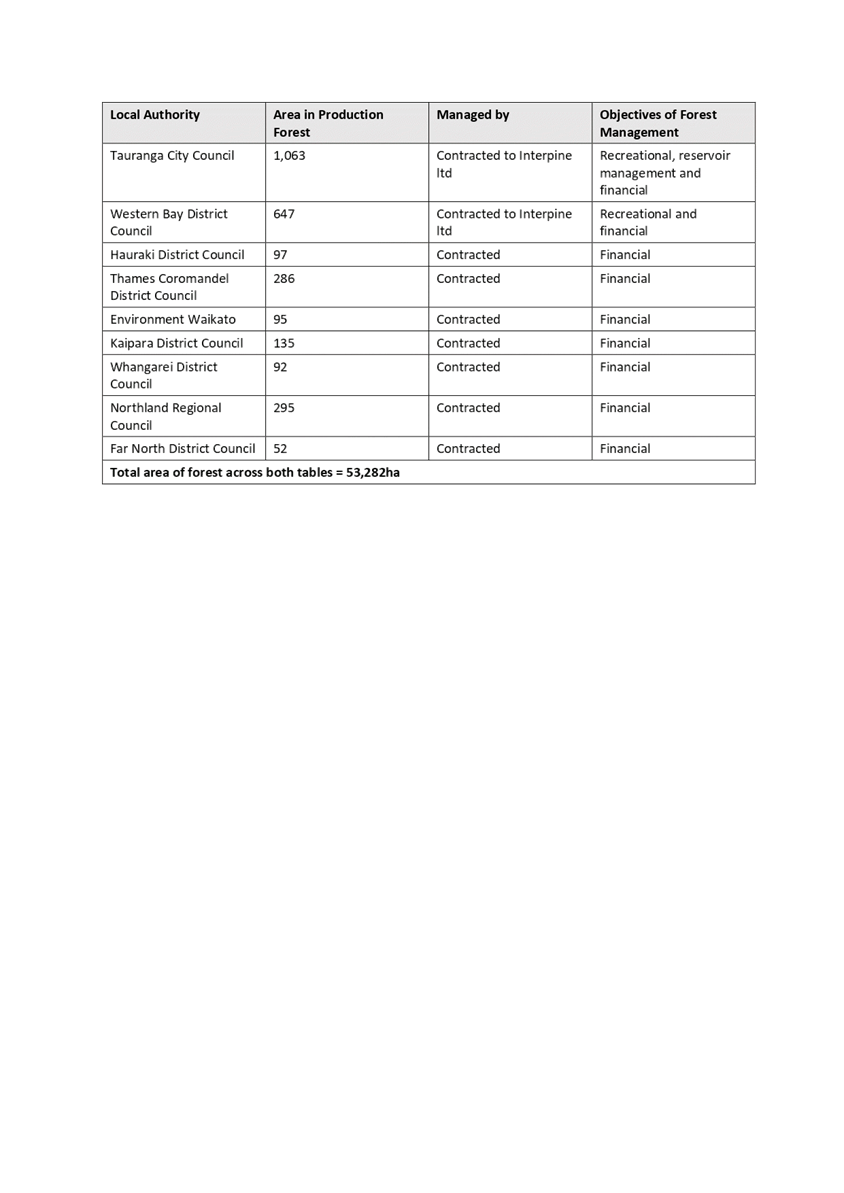
|
HBRC Forests and Tangoio
Soil Conservation Reserve Key Financial Figures
|
Attachment 2
|

|
Tutira
photo points post-Cyclone Bola
|
Attachment 3
|
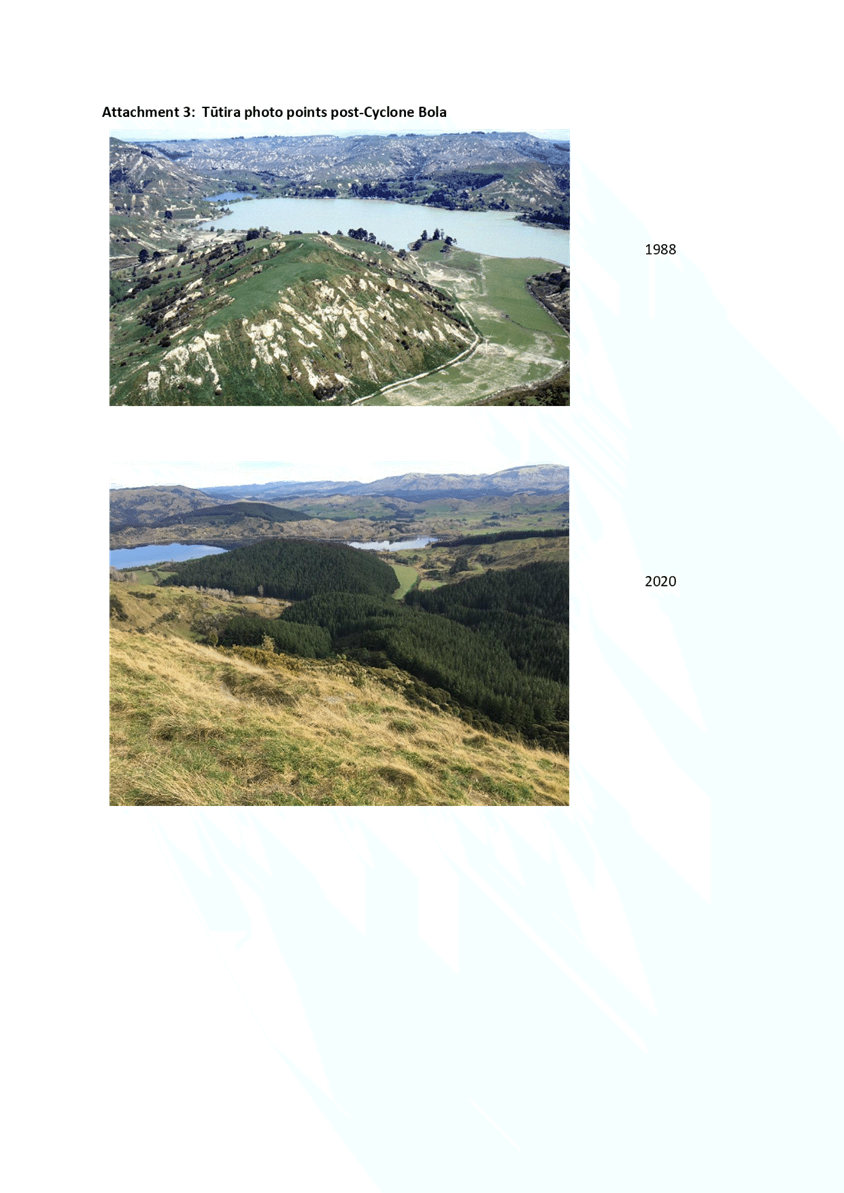
|
Waihapua
Forest Map
|
Attachment 4
|
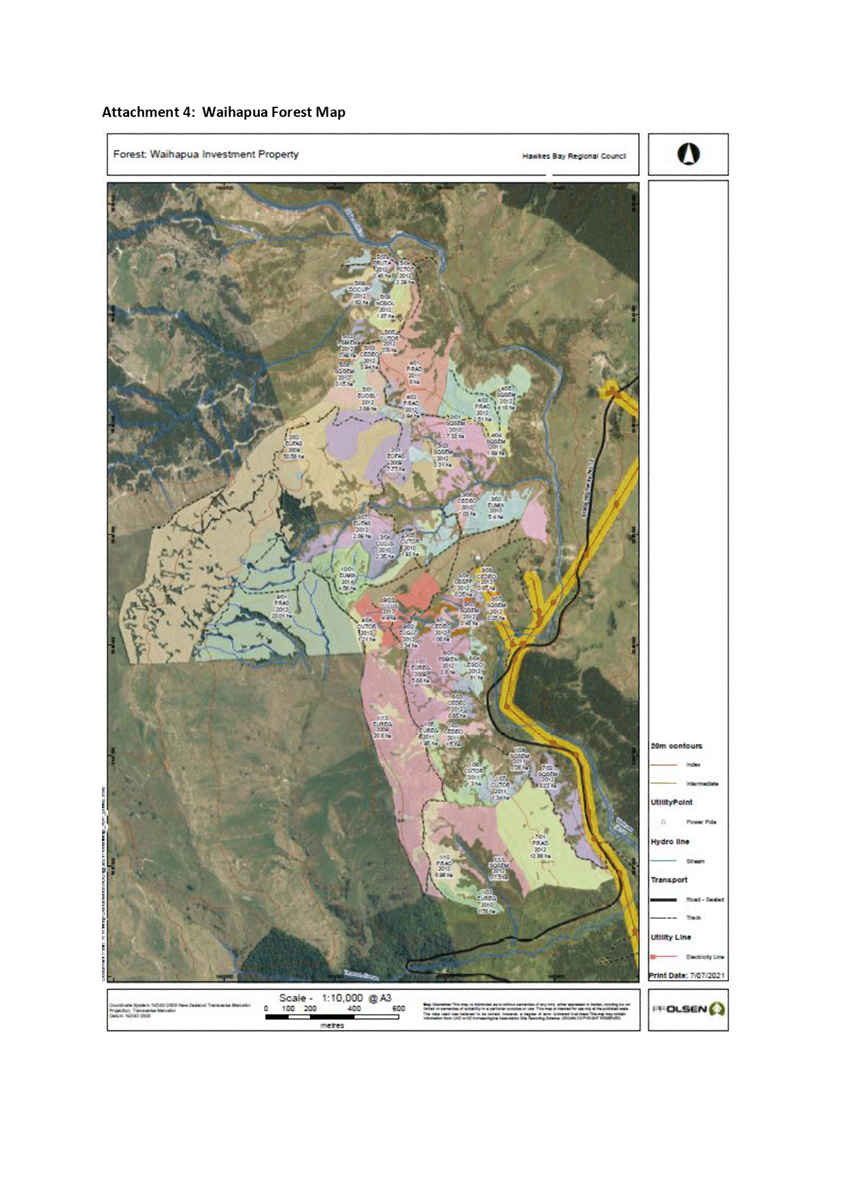
|
Waihapua
photo point 1988 and 2021
|
Attachment 5
|
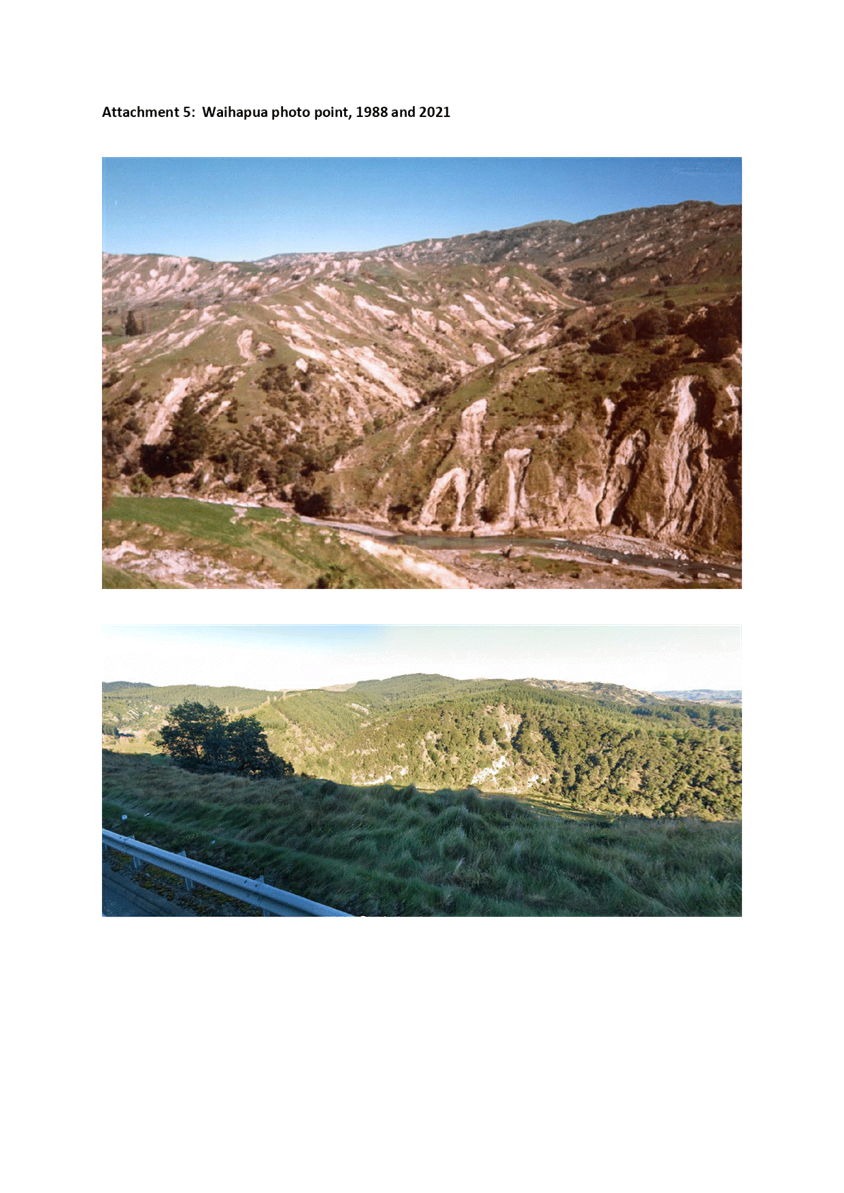
HAWKE’S
BAY REGIONAL COUNCIL
Finance
Audit & Risk Sub-committee
02 March
2022
Subject: Tūtira Mānuka
Plantation Update
Reason for Report
1. This report is provided to
update Council on the status including financial returns of the Tūtira
mānuka plantation as requested in Finance, Audit and Risk Sub-committee
(FARS) on 15 December 2021 and following the newspaper article “Hawke's Bay Regional Council's
mānuka honey venture makes dismal returns” published in
‘Stuff’ on 12 November 2021.
Executive Summary
2. 136ha of Tūtira Regional Park was planted
in mānuka over the period 2011 to 2013, approximately 104ha of which has successfully
established and matured to form a mānuka plantation.
3. The objectives of the
plantation were to trial and demonstrate the viability of high UMF mānuka as an
economic soil conservation crop alternative to plantation forestry on
erosion-prone land and to facilitate the eventual reversion of the steep lands
above the Lake to native forest.
4. These
objectives have now been met. Native reversion is well underway, and the
plantation has demonstrated that mānuka plantations can be effectively
established in steep hill country and earn a positive return on investment
while increasing erosion control and reducing sediment loss.
5. Honey
production from the plantation to date is well below forecasts used in the
feasibility planning for the plantation. The primary reasons for the poor
performance are difficulties in timing hive placement and honey harvest to
align with honey flow, weather conditions affecting honey collection during the
critical window of honey flow, and a reduction in the volume of honey able to
achieve MPI’s recently introduced definition of ‘mānuka’
and therefore being downgraded to bush blends.
6. The lower than
forecast honey returns have been partly compensated for by higher than forecast
carbon returns. Currently, the plantation has not provided a positive return on
investment, but this is not unusual as all of the costs have been incurred in
the establishment stage and revenue has only recently begun to come in. This
will improve over time and the 50-year projection is for an IRR of 8%.
7. The above is,
however, predicated on HBRC trading carbon. No carbon from HBRC’s carbon
portfolio has been traded to date. If carbon is not traded, the return from the
plantation would be in the realm of -$800,000 over a 50-year period.
Strategic Fit
8. The Tūtira mānuka
plantation contributes to HBRC’s strategic plan goals in the following
ways:
Smart sustainable landuse
8.1. Tūtira Regional Park
was purchased by Hawke’s Bay Regional Council under the Soil Conservation
and Rivers Control Act (1941) with the primary objective of managing the land
to maintain and improve the water quality in the two lakes, Tūtira and
Waikopiro, and secondly to develop a quality outdoor recreation environment for
the people of Hawke’s Bay. Native forest cover has been widely agreed in
various consultation processes with the community, tāngata whenua, and
subject matter experts to be the landuse most conducive to those objectives.
8.2. The plantation is enabling
a transition to native forest at 8% IRR over 50 years. This is not as high a
return as exotic plantation forestry could achieve, but as above, is a much
more suitable use for the land given the overriding objectives. It is also more
than was achieved through grazing the land.
8.3. The plantation has made a
significant contribution to the development of sustainable landuse options
nationally. As the only plantation of 100ha or more at that time, it was an
important case study and research site in the High Performance Mānuka
Plantations PGP Programme, which ran from
2011 – 2018 and which HBRC
was a key investor in. It was also one of two key sites used by Landcare
Research scientists in assessing the erosion control potential of the landuse[4].
Comvita Ltd continues to undertake its own research in the plantation to
determine the factors influencing honey production.
Water
quality safety and certainty
8.4. The mānuka plantation
has effectively revegetated 100ha (12% of the catchment draining to Lake
Tūtira) of erosion-prone soils in one of the most sensitive catchments (in
terms of environmental, cultural and recreational values) in Hawke’s Bay.
Healthy
and functioning biodiversity
8.5. The mānuka plantation
has significantly increased the area of indigenous vegetation in the Lake
Tūtira catchment. Mānuka is a primary colonising species and creates
the conditions for other secondary species to establish and emerge through it
over time, leading eventually to mature native forest.
Sustainable
services and infrastructure
8.6. In increasing
soil protection in the event of significant rainfall events, the mānuka
plantation contributes to the protection of the landscape, infrastructure and
services of the Regional Park (Attached).
9. The Tūtira mānuka
plantation aligns with other significant work to conserve soils and water
quality in the Tūtira catchment, including the Maungaharuru
Tangitū-led Tūtira Mai i Ngā Iwi and Te Waiū o
Tūtira projects, and provides valuable lessons for the Right Tree,
Right Place Project and HBRC’s objectives in promoting regional
afforestation.
Background
10. Successive management plans
for the Park since its purchase, provided for the reversion of the steep land
above the Lake to native forest through managed light grazing. This was seen to
be the most appropriate landcover given the objectives described previously and
the cultural and biodiversity values of the property.
11. 4ha of mānuka was
established in 2011 to assess the viability of converting the wider 136ha
steepland area to a mānuka
plantation.
The objectives were to speed the reversion to native occurring naturally, trial
what was then a nascent but promising sustainable landuse alternative to
grazing and plantation forestry and use the results to inform landowners and a
planned HBRC ‘Trees on Farms’ regional afforestation programme, all
while making a greater than 7% return on investment.
12. Though honey had been
harvested from wild trees for some time, establishing plantations by planting,
using cultivars bred for high UMF honey production, had not been attempted at
any scale before. UMF stands for
‘Unique Manuka Factor’ and is a measure of the unique type of
antibiotic activity naturally present in Manuka honey.
13. Consultants advising on the
venture considered HBRC’s threshold ROI of 7% would be easily achieved
and that the IRR was likely to be around 19.5%. This advice was given with the
caveat …”it should be pointed out that no large-scale areas of
known high UMF variety mānuka have been established. Thus costs and
returns to date are best estimates[5]”.
14. The 4ha trial planting
established successfully and Corporate and Strategic Committee
14 September 2011 approved the planting of a further 45ha as unbudgeted
expenditure from Council reserves, with the remainder of the 136ha to be
approved via the long-term plan process pending further successful
establishment.
15. Ultimately, some 104ha of
mānuka were successfully established. The seedlings were supplied by
Comvita Ltd and had been bred for high UMF levels and for the timing of their
flowering.
16. A contract signed by HBRC
and Comvita in 2012 gave Comvita exclusive rights to beekeeping on the
property. The contract is reviewed every 7 years, with the last review having
been carried out in 2019. Given the high percentage of high UMF honey in the
previous year, in the 2019 review HBRC negotiated a change from a fixed 18.5%
percent share of honey revenue to the use of a ‘sliding scale’,
with percentage share of revenue based on the UMF value of the honey (Table 1
below).
Table 1: Sliding Scale, HBRC revenue share
|
UMF
|
HBRC Share of Net Revenue
|
|
UMF <5
UMF 5-8
UMF 8-11
UMF 11-15
UMF 15+
|
5%
10%
20%
30%
35%
|
17. The first commercial
harvest from the plantation occurred in 2018 and has continued annually since.
Key metrics are shown in Table 2 below. The 2020-2021 season harvest was badly
affected by poor weather and triggered the floor payment of $50 per hive.
18. Preliminary results from
the 2022 harvest indicate an improved return this year. Hive placement and
removal was aligned more strictly to the main nectar flow, resulting in a
higher percentage (estimated ~80%) of monofloral honey. UMF levels are sitting
in the range 4-6, with estimated final levels of 7-9 after the 10-month presale
storage period. Mānuka honey is stored for a period of time prior to sale
to allow greater levels of UMF to be converted from its chemical precursor
(DHA).
19. The improved timing was
made possible by using a helicopter to place hives in locations where
previously track limitations had restricted vehicle access in wet ground
conditions. It remains to be seen whether the helicopter cost is justified by
the increased honey returns. Once the season’s final harvest report is
received, staff will assess the costs and benefits of improving track access
for greater returns. Given the overriding soil conservation and aesthetic
considerations, doing so would only be considered if the impacts on these were
minimal.
Table 2: Key Metrics of Harvest to Date,
Tūtira Plantation
|
|
Hive numbers
|
Kg Honey (total)
|
Kg Honey (per hive)
|
% UMF 10 or higher (after x months
storage)
|
HBRC Return (exc GST)
|
Initial forecast in business case
|
|
2018
|
72
|
1,977
|
27
|
13%
|
$6,334
|
$19,384
|
|
2019
|
72
|
2,187
|
30
|
0
|
$6,561
|
$24,829
|
|
2020
|
96
|
5,598
|
58
|
0
|
$5,835
|
$28,314
|
|
2021
|
112
|
542
|
5
|
0
|
$5,600
|
$28,314
|
|
2022 (Preliminary results)
|
100
|
1,813
|
18
|
To be confirmed
|
To be confirmed
|
$28,314
|
20. As shown in the table,
notwithstanding the potential improvements in the current season, honey returns
have been short of those predicted in the initial business proposition
presented to council in each year to date. This was reported by staff in
‘significant activities’ recently, where it was picked up and
reported on by media. This paper aims to update Councillors on the status of
the mānuka plantation accordingly.
Key Issues
Honey volumes
21. The initial business case
estimated 40kg of honey production per hive once the plantation was
established. Though the first three harvests following a promising trend to
achieving this, the extremely poor 2021 harvest achieved only 5kg per hive, and
the 2022 is also well-short at 18kg per hive.
22. While the poor 2021 harvest
volume has been attributed to poor weather conditions for nectar production and
collection, the 2022 volume was due to a decision to time hive placement and
removal more strictly around mānuka nectar flow and therefore sacrifice
some quantity for quality. This has led to an increase in honey quality as
described previously, but the ultimate effect of this trade-off on revenue
(including helicopter costs) won’t be known until the harvest report is
available in early March 2022.
23. The main factors limiting
honey volumes can be summarised as:
23.1. Climate and terrain –
Bees fly
less, and therefore gather less nectar, in high winds and wet conditions. Much
of the plantation is very exposed and faces directly into the prevailing north-west
wind.
23.2. Establishment – As described earlier, only
around 104ha of the total 136ha of mānuka planted have established
successfully, an establishment rate of 76%. Though some failure has been due to
competition with grasses and weeds or browsing by stock or hares, the general
pattern is of successful establishment on more stable slopes and poor
establishment in the skeletal soils of the many landslide scars (Attached).
23.3. Attempts have been made to
infill these failed areas with further mānuka, but these have failed, as
obviously the same ground conditions remain. It’s possible, in a
spring-summer like 2021-2022 to date, establishment would be more successful,
but these aren’t possible to predict and plan for, and staff have opted
to instead leave the bare areas to revert naturally, sometimes via seed from
the surrounding mānuka, but more often from that of the dominant kanuka.
23.4. Flowering timing – Another factor influencing
honey volumes in the Tūtira plantation is the spread in flowering timing
of the cultivars. The thinking when the plantation was established was that the
approximately 4-week mānuka nectar flow period could be increased by up to
double, by using early, medium and late flowering cultivars, instead of the
same cultivar across the whole plantation. In practice, it seems that weather
conditions and temperatures when the first cultivars flower are restricting
nectar flow, and they constitute an underutilised part of the plantation.
Honey value
24. While demand and therefore
prices for multifloral mānuka and non-mānuka honey has declined over
recent years, it has remained strong for monofloral mānuka honey. The
significant range in mānuka honey values shown in Table 3 below reflects
the variance in value between multifloral and monofloral mānuka honeys and
different UMF values.
25. The initial business case
for the plantation used an average honey value of $30 per kg. At a forecast
average of $22, the 2021-2022 season looks like being the closest to this the
plantation has achieved to date. Average honey values in previous seasons
ranged from $11.15 to $17.66.
Table 3: Prices and Returns for Apiculture
Products, 2014-2020[6]

26. As described previously,
the ‘sliding scale’ method of payment share is more favourable to
HBRC at high UMF levels. Unfortunately, UMF levels of honey harvested since the
contract was renegotiated have shown a general trend of decline, and no honey
since that time has achieved a UMF of 10 or higher.
27. The main factors
influencing the UMF level of honey can be summarised as:
27.1. Genetics – The UMF value of honey is
determined in most part by the amount of the antibacterial compound
methylglyoxal it contains. Methylglyoxal content in mānuka honey is in
turn determined in most part by the level of dihydroxyacetone (DHA) in
mānuka nectar. This is because DHA transforms naturally into methylglyoxal
over time as the nectar is stored by bees and turns into honey. Selection for
high UMF mānuka cultivars is therefore based on DHA levels measured in
nectar.
27.2. DHA levels sampled from the
Tūtira plantation in 2014 were around twice as high as those in nearby
wild mānuka, indicating the cultivars planted were likely to produce
relatively high UMF rated honey.
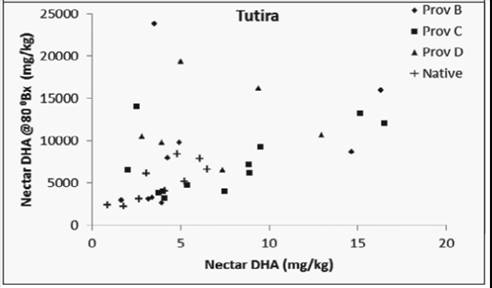
Figure 1: Scatterplots of nectar dihydroxyacetone (DHA)
content and normalised nectar DHA content in Plantation and Wild Mānuka at
Tūtira.[7]
27.3. Alternate floral sources
– Mānuka
nectar is not particularly desirable to bees, and if there are other options
available, they will gather nectar preferentially from these. Depending on the
extent of nectar collected from alternate sources, this results in lower UMF
values, multi rather than monofloral honey, or at worst non-mānuka honey.
27.4. Alternate floral sources at
Tūtira are predominantly blackberry, gorse, clover, and thistles.
Blackberry and gorse have grown within the plantation as it has established
over time. Control by ground is impractical and cost-prohibitive on that scale.
Trials of various rates and types of herbicides have been carried out and a
combination that will control blackberry (gorse was not considered as it is
less of an issue) without killing mānuka has been identified, however, the
cost of implementing this on a wider scale is not seen as justified by the
benefits at this point.
27.5. Reducing clover flowering
via hard grazing has been attempted but with limited success. This has been due
to the difficulty of managing the relatively low number of cattle on the
property in large paddocks on that scale, the need for the grazier to
prioritise animal health and the economics of his operation, and also the
pugging and other damage done to walking tracks through the plantation in the
process. Grazing will continue in most paddocks going forward, and clover cover
will continue to decrease over time as increasing mānuka canopy cover
continues to shade it out. Grazing will need to be excluded from 27ha of the
plantation from the end of this month, due to the need to keep stock from
accessing newly planted pine trees and the impracticality of fencing to exclude
them.
27.6. Timing – Honey boxes in place
before or after the mānuka nectar flow will begin to be filled with honey
from other floral sources, devaluing it as described previously. Timing
placement and removal requires a trade-off between achieving maximum volumes of
mānuka honey with minimal dilution from other floral sources.
27.7. Tracks in the plantation
are unmetalled, narrow and dry weather access only, and wet conditions have in
the past delayed hive placement. Some improvements for beekeeper access have
been carried out, but the level of improvement required to create all-weather
access is yet unjustified by the level of harvest returns.
27.8. Regulatory changes – In 2008, MPI brought into
force a new science-based definition of mānuka honey. The new definition
was established to give our trading partners greater confidence in the
mānuka honey industry, following cases of mislabelling, artificial
manipulation of UMF levels, and sales of more mānuka honey than was being
produced.
27.9. To meet the definition of
mānuka honey, samples must contain a set of four chemical markers
(3-Phenyllactic acid, 2’-Methoxyacetophenone, 2-Methoxybenzoic acid, and
4-Hydroxyphenyllactic acid) and 1 genetic marker (DNA from mānuka pollen).
To qualify as monofloral, the levels of 3-Phenyllactic acid and
2’-Methoxyacetophenone must be present at greater prescribed levels than
in multifloral honey.
27.10. The new definition is
generally agreed to have increased the proportion of honey classified as
multifloral or non-mānuka, leading to a glut in supply and a fall in
prices for these grades as described previously. This has negatively affected
the Tūtira plantation.
27.11. Soil conditions – Mānuka produces higher
UMF honey in low pH and low fertility soils. No fertiliser is applied to the
plantation, and at this point the feasibility or benefits of lowering the pH of
the soils has not been investigated.
Carbon
trading policy
28. The mānuka plantation
will only meet HBRC’s investment requirements if a number of the NZU it
has earned are sold. This is similar to cashflows for the Tūtira Forest replanting
plan - the cashflows presented for the option approved by Council are only
applicable if the NZU revenue is received as modelled in the cashflow analysis.
29. No NZU from the HBRC
emissions register have been sold to date, but this is set to change soon as
Council has approved the sale of NZU to finance a Climate Change Ambassador
role and work required in HBRC’s Central Hawke’s Bay Forests.
30. Table 4 below shows the IRR
that would be achieved from the plantation under 3 scenarios and demonstrates
the significant impact NZU sales have on the profitability of the plantation.
31. HBRC is yet to confirm a
carbon trading policy, but to date has had a conservative approach. Table 5
shows the minimum number of NZU HBRC needs to sell at the current price of $82
per NZU to break even and to meet the 4% cash return targets specified in the
HBRC Investment Strategy. If the price of NZU continues to climb, these numbers
will obviously fall.
Table 4: IRR at different NZU Sale Scenarios
|
Years earned
|
NZU Price at that time
|
Scenario 1:
First NZU sales in 2022
|
Scenario 2:
NZU sold as earned
|
Scenario 3:
No NZU sales
|
|
2018
|
$23
|
-
|
$19,458
|
-
|
|
2019
|
$25
|
-
|
$10,650
|
-
|
|
2022
|
$82
|
$169,084
|
$64,780
|
-
|
|
Total
|
$169,084
|
$91,560
|
-
|
|
IRR over 50 years
|
8%
|
8%
|
NA
$830,000 loss
|
Table 5: Minimum NZU sale requirements
to break even on investment and achieve minimum HBRC cash return requirement of
4% IRR (at $83 per NZU)
|
|
NZU necessary to sell
|
Years of sequestration
|
|
Break even scenario
|
10,002
|
2011-2031
|
|
4% cash return scenario
|
13,890
|
2011-2034
|
Impact on the Community or Council
32. Staff consider that despite
the lower-than-expected returns from the mānuka plantation, it has been a
successful investment for Council and has created a positive impact on the
Community. The other landuse options for the land were continued grazing,
afforestation in a production forestry species, or afforestation in mixed native
species, and given the special nature of the site and the prohibitive cost of
the latter option on such a massive scale, the plantation is a good example of
the right tree in the right place.
33. The plantation has
significantly increased biodiversity, aesthetic, and soil conservation values
on the Park (Attached), and has played an important role as a research site in
the wider sustainable land management scene.
Other Council’s experiences
34. Though other Regional
Councils have contributed to research into mānuka plantations as a
landuse, the Tūtira plantation is the only known Council-owned mānuka
plantation in the country.
Next Steps
35. Staff will continue to work
with Comvita to trial different beekeeping and plantation management approaches
in order to find out more about the variables affecting mānuka honey
production and improve the performance of the plantation.
36. Staff will also continue to
work with Comvita to establish the productive capacity of the plantation and
the level of investment in tracks and other management justified by honey
revenue.
37. Bird feed species will
begin to be established throughout the plantation over time to encourage seed
dispersal from frugivore bird species and subsequently speed the regeneration
of secondary native forest species.
38. Staff will continue to
refine plant pest control and grazing programmes to better minimise alternate
floral sources.
39. Staff will report back to
Council when the 2022 harvest report is available.
Decision Making Process
40. Council and its committees
are required to make every decision in accordance with the requirements of the
Local Government Act 2002 (the Act). Staff have assessed the requirements in
relation to this item and have concluded:
40.1. This agenda item is in
accordance with the Finance, Audit and Risk Sub-committee Terms of Reference,
specifically “The Finance, Audit and Risk
Sub-committee shall have responsibility and authority to (2.4) monitor the performance of Council’s investment
portfolio”.
40.2. As this report is for
information only, the decision making provisions do not apply.
Recommendation
That
the Finance, Audit and Risk Sub-committee receives and notes the “Tūtira
Mānuka Plantation Update” staff report.
Authored by:
|
Ben Douglas
Forests and Reserves Officer
|
Russell Engelke
Team Leader Open Spaces
|
|
Nicole Simpson
Management Accountant
|
|
Approved by:
|
Chris Dolley
Group Manager Asset Management
|
Jessica Ellerm
Group Manager Corporate Services
|
Attachment/s
|
1⇩
|
Tutira Camping Ground Post-Cyclone
Bola
|
|
|
|
2⇩
|
Variation in establishment on
different slopes and soils
|
|
|
|
3⇩
|
Photo point - 2014 and 2022
|
|
|
|
Tutira
Camping Ground Post-Cyclone Bola
|
Attachment 1
|
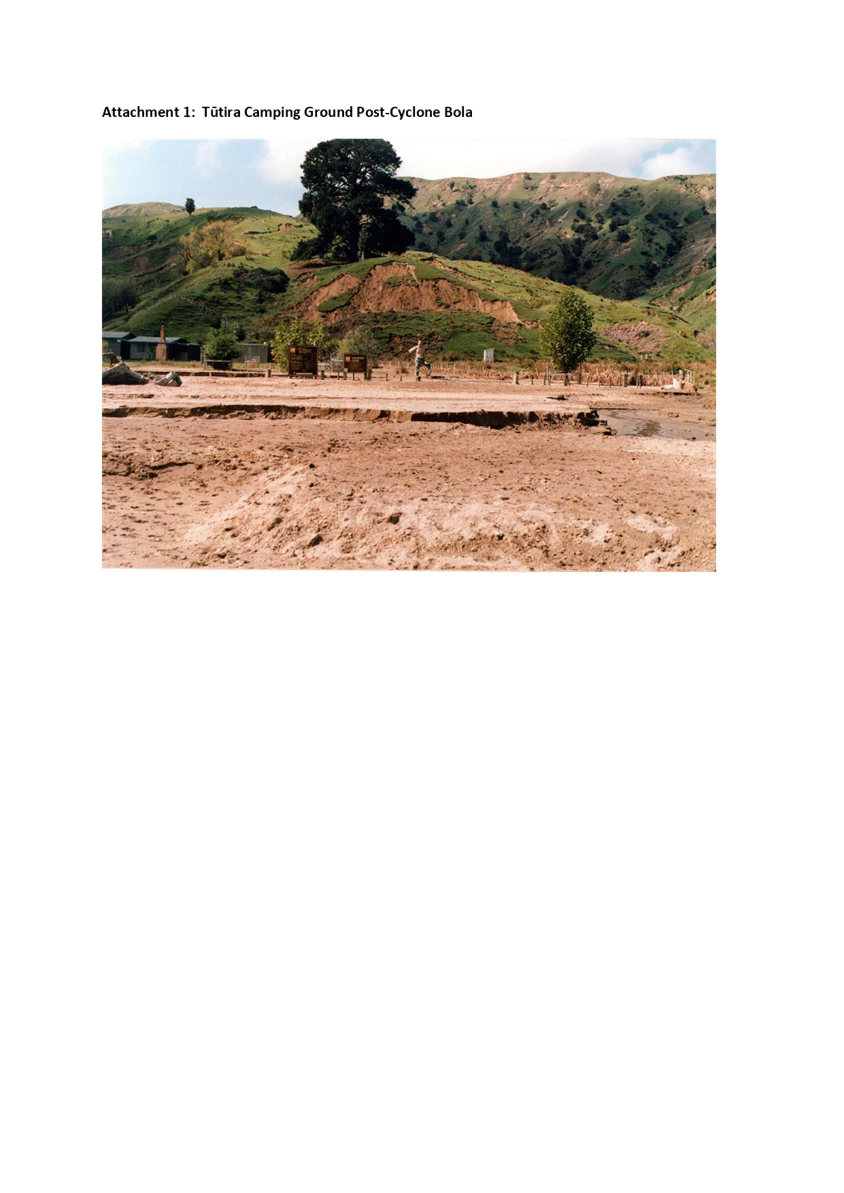
|
Variation
in establishment on different slopes and soils
|
Attachment 2
|
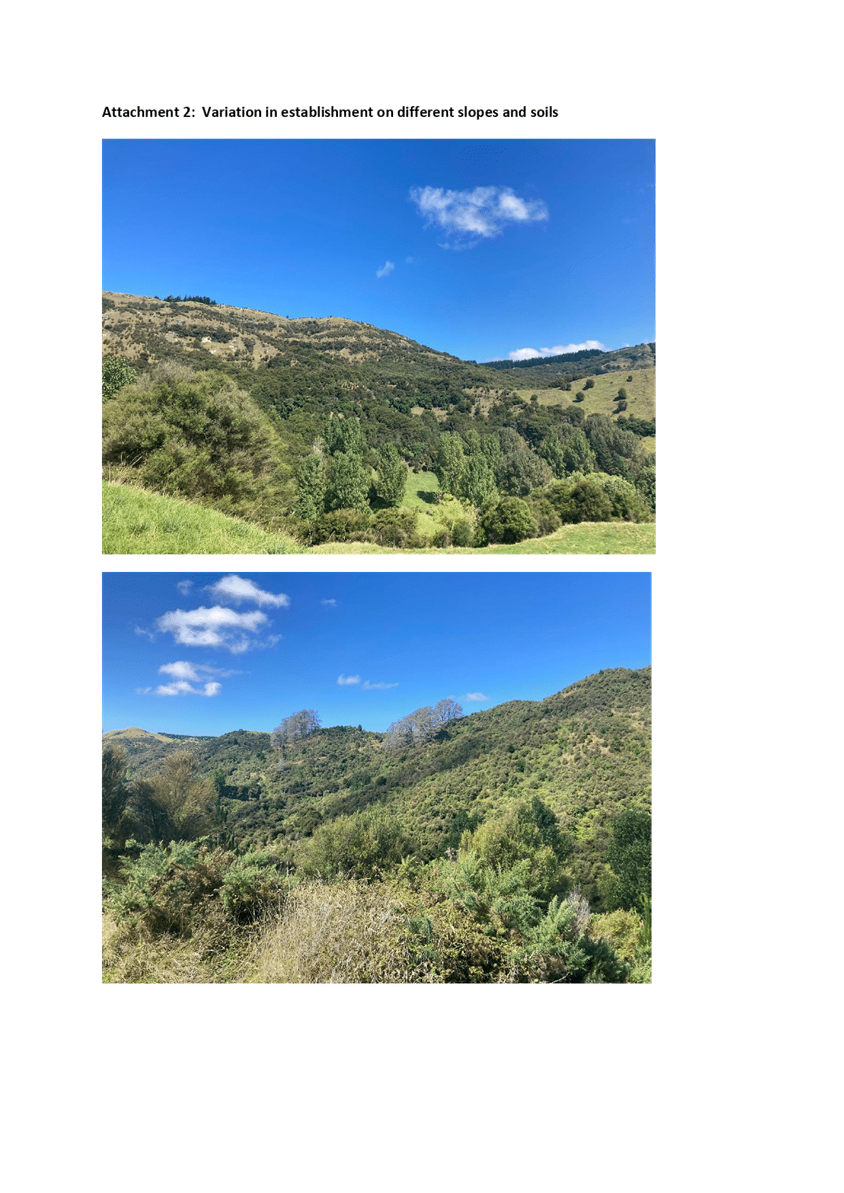
|
Photo
point - 2014 and 2022
|
Attachment 3
|
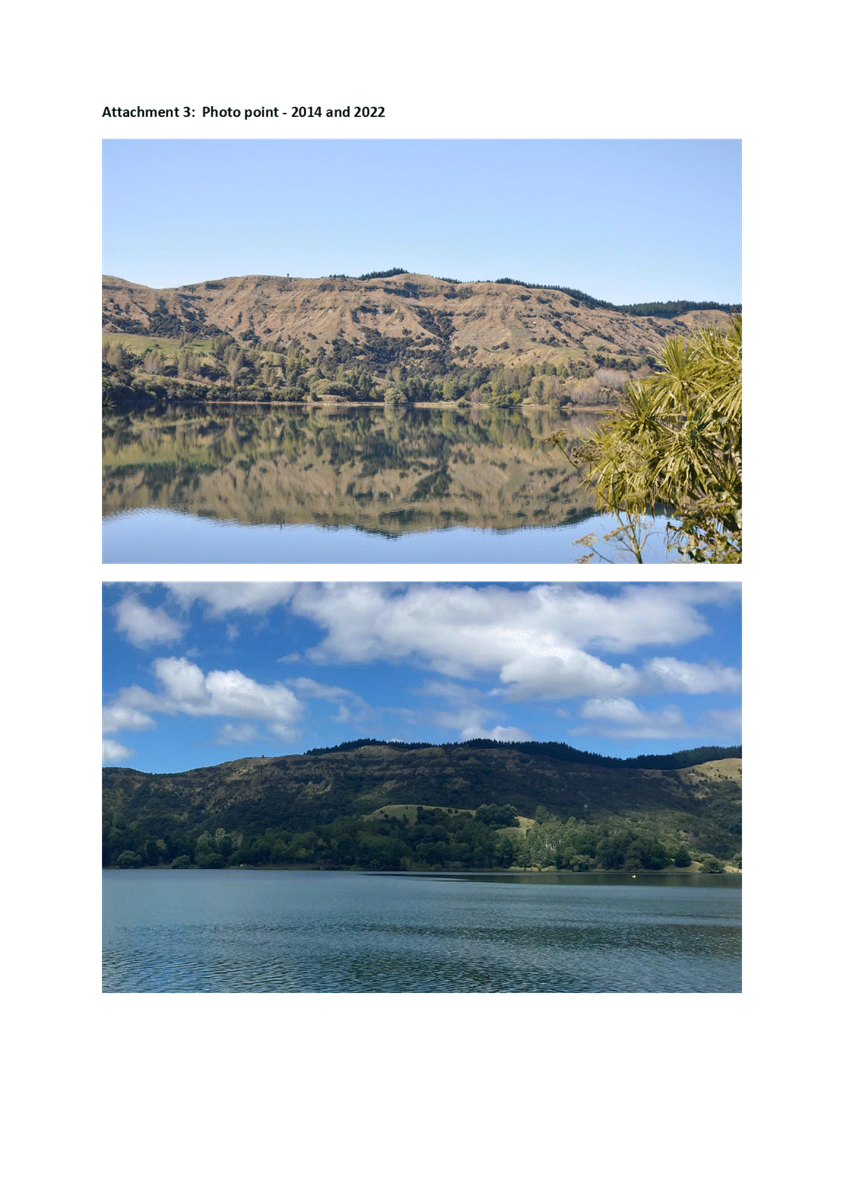
HAWKE’S
BAY REGIONAL COUNCIL
Finance
Audit & Risk Sub-committee
02 March
2022
Subject: Internal Assurance Dashboard
- Corrective Actions Status Update
Reason for Report
1. This item updates the
Finance, Audit and Risk Sub-committee (FARS) on the progress carrying out
corrective actions that respond to internal audit findings as previously
reported to the FARS.
Officers’
Recommendation
2. Council officers recommend
that the sub-committee considers and notes the internal assurance dashboard
corrective action status update, with a view to confirming the adequacy of
corrective actions undertaken and reporting as such to the Corporate &
Strategic Committee (C&S).
Discussion
3. The purpose of the
corrective action status update is to provide oversight to the FARS on the
progress of actions taken to address open internal assurance findings.
The dashboard gives visibility of the following:
3.1. Open findings of the
tracking status milestones plus milestones completed since last reported
3.2. Milestones to be completed
by the next FARS report
3.3. Summary of closed actions
since the last FARS report
3.4. Lastly, a summary of the
overall progress to close out the full audit review through the reporting of
all previous closed actions.
4. A separate agenda item has
been prepared for this meeting, accompanies this item providing a detailed
progress update on the Talent Management internal audit by the People &
Capabilities Manager.
Financial and Resource Implications
5. There are no financial
implications or additional resource requirements resulting from this internal
audit programme update.
Decision Making Process
6. Council and its committees
are required to make every decision in accordance with the requirements of the
Local Government Act 2002 (the Act). Staff have assessed the requirements in
relation to this item and have concluded:
6.1. Any decision of the sub-committee
is in accordance with the Terms of Reference and decision-making delegations
adopted by Hawke’s Bay Regional Council 25 March 2020, specifically
the Finance, Audit and Risk Sub-committee shall have responsibility and
authority:
6.1.1. receive the internal and
external audit report(s) and review actions to be taken by management on
significant issues and recommendations raised within the report(s).
6.1.2. Ensure that recommendations
in audit management reports are considered and, if appropriate, actioned by
management
6.1.3. Report to the Corporate and
Strategic Committee to fulfil its responsibilities.
Recommendations
That the Finance, Audit and Risk
Sub-committee:
1. Receives and notes the
‘Internal Assurance Dashboard - Corrective Actions Status Update’
staff report and accompanying dashboard.
2. Confirms that management
actions undertaken or planned for the future adequately respond to the findings
and recommendations of the internal audits.
3. Confirms that the dashboard
reports provide adequate information on the progress of corrective actions and
the progress of the approved Annual Internal Audit programme.
4. Reports to the Corporate
and Strategic Committee, the Sub-committee’s satisfaction that the
Internal Assurance Programme Update provides adequate evidence of the adequacy
of Council’s internal assurance functions and management actions
undertaken or planned respond to findings and recommendations from completed
internal audits.
Authored by:
|
Olivia Giraud-Burrell
Quality & Assurance Advisor
|
Helen Marsden
Risk & Corporate Compliance
Manager
|
Approved by:
|
Jessica Ellerm
Group Manager Corporate Services
|
|
Attachment/s
|
1⇩
|
Internal Assurance Dashboard
February 2022
|
|
|
|
Internal
Assurance Dashboard February 2022
|
Attachment 1
|

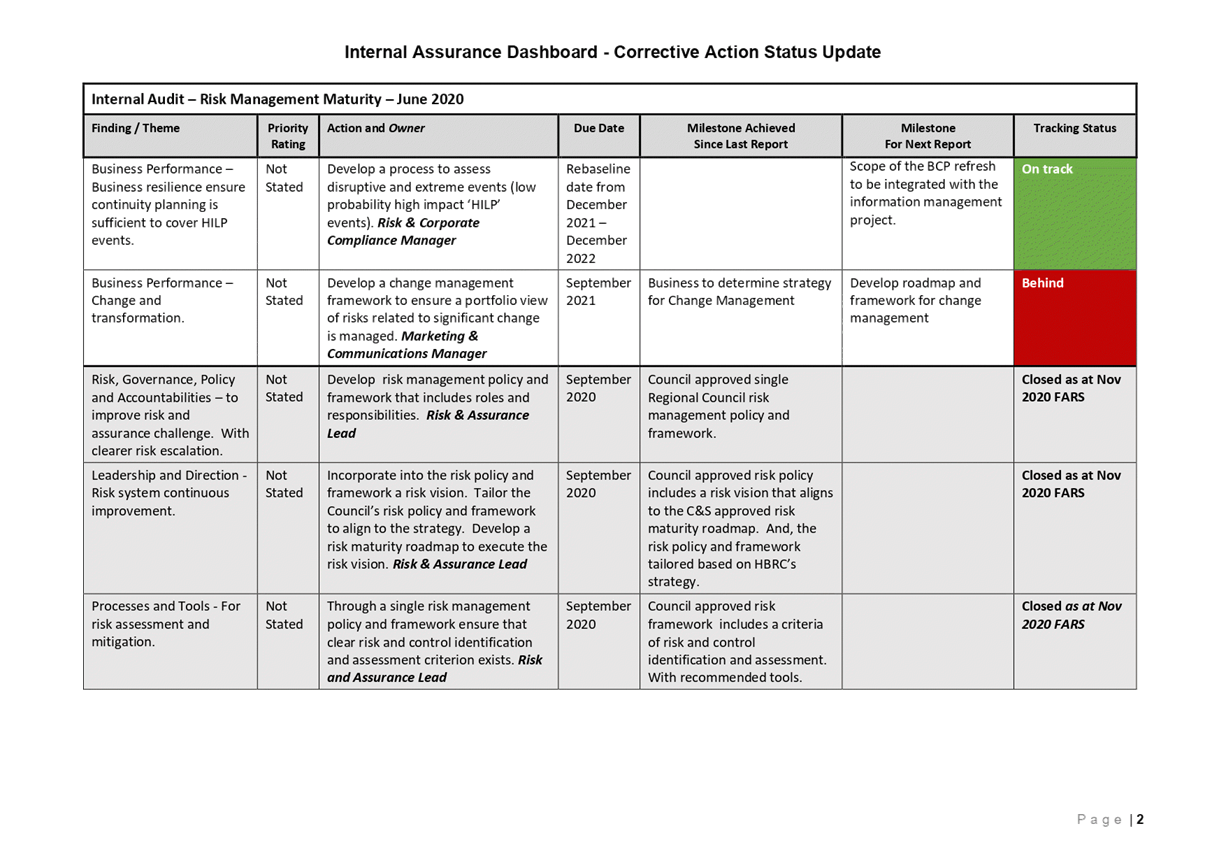
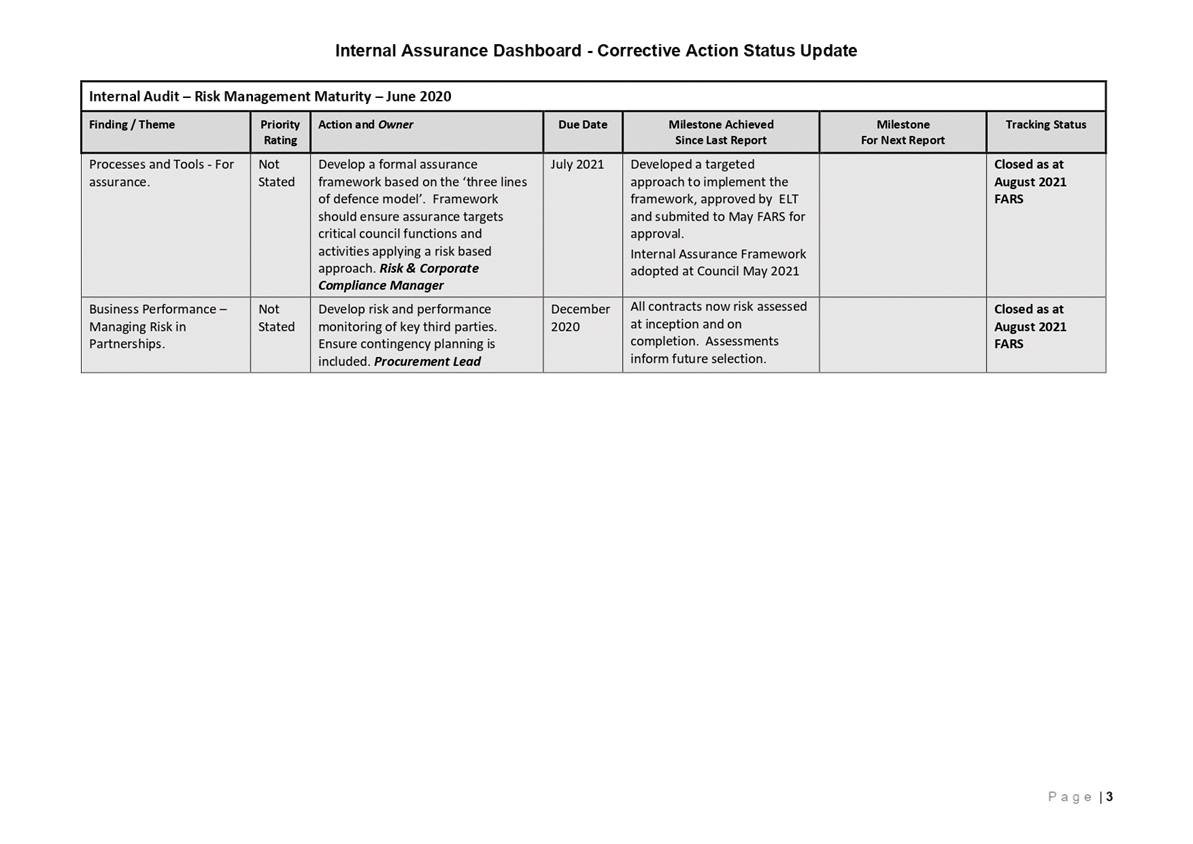
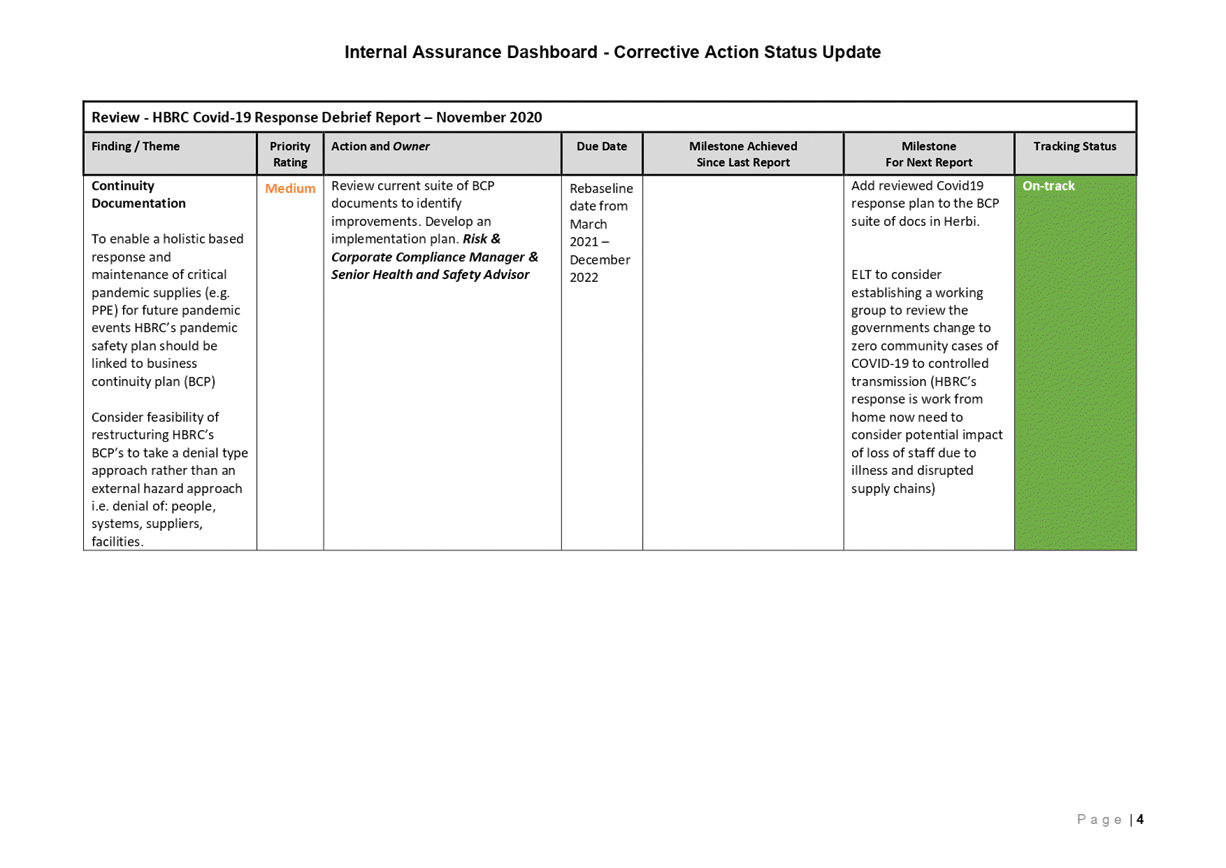
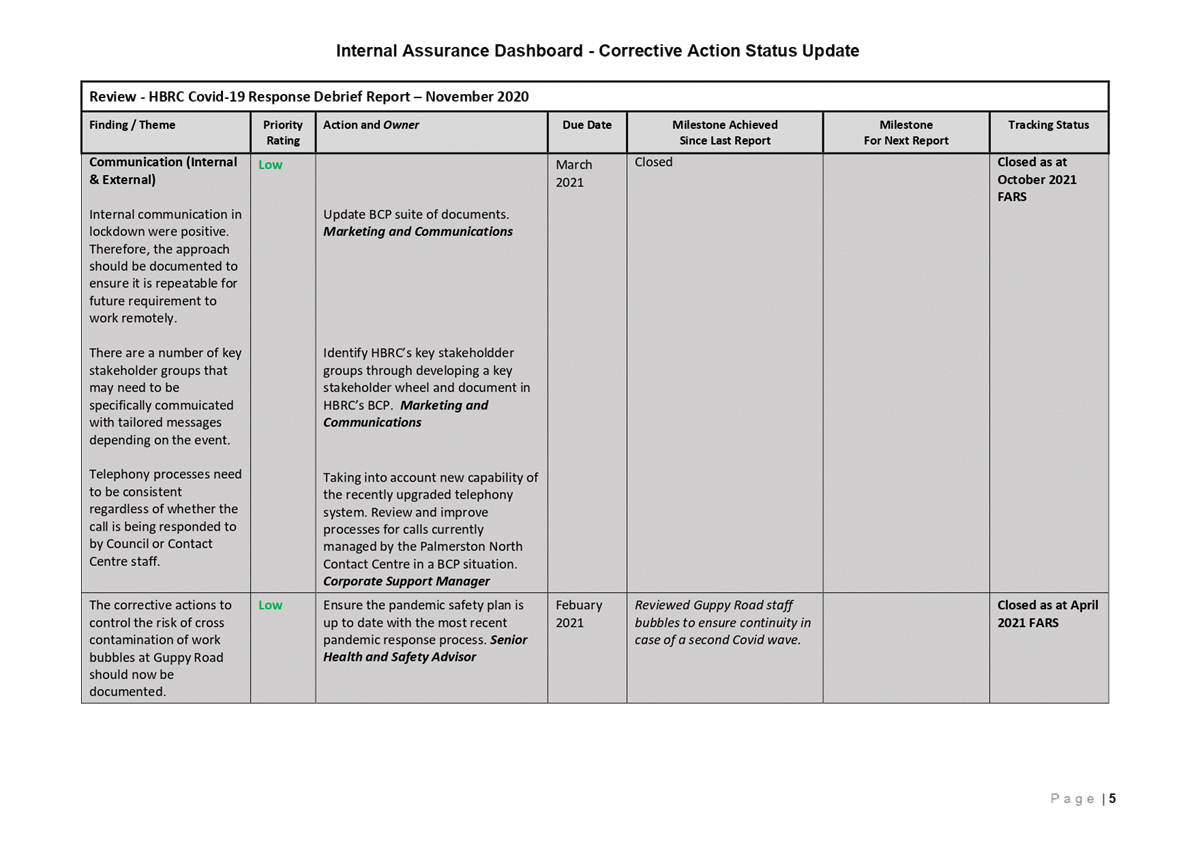
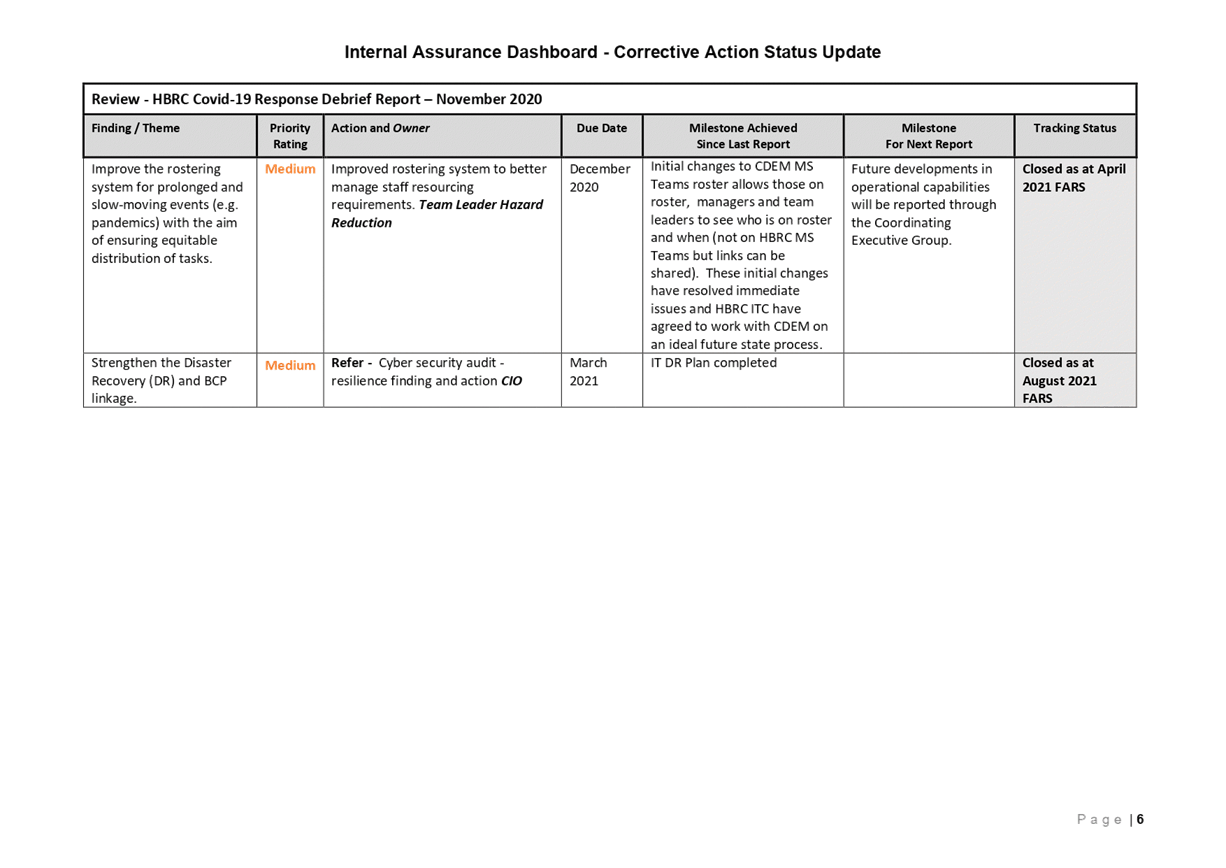
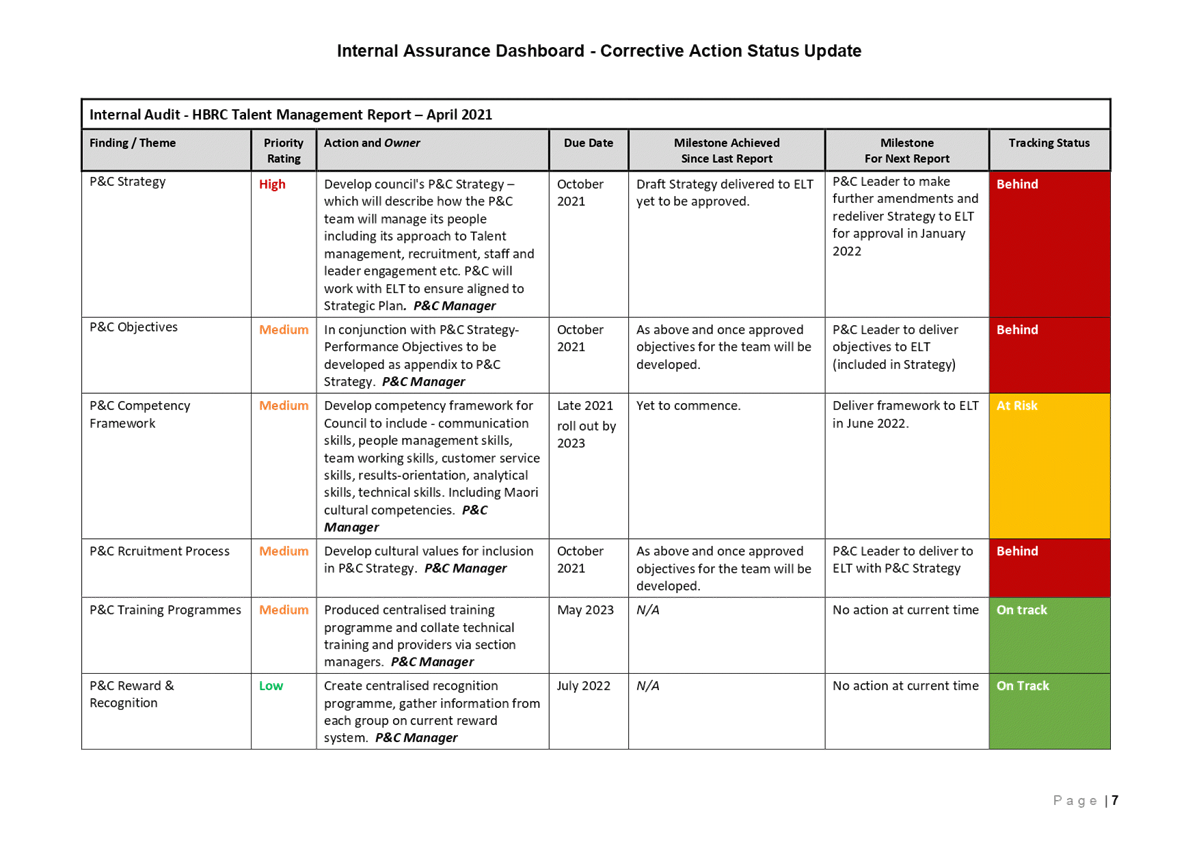
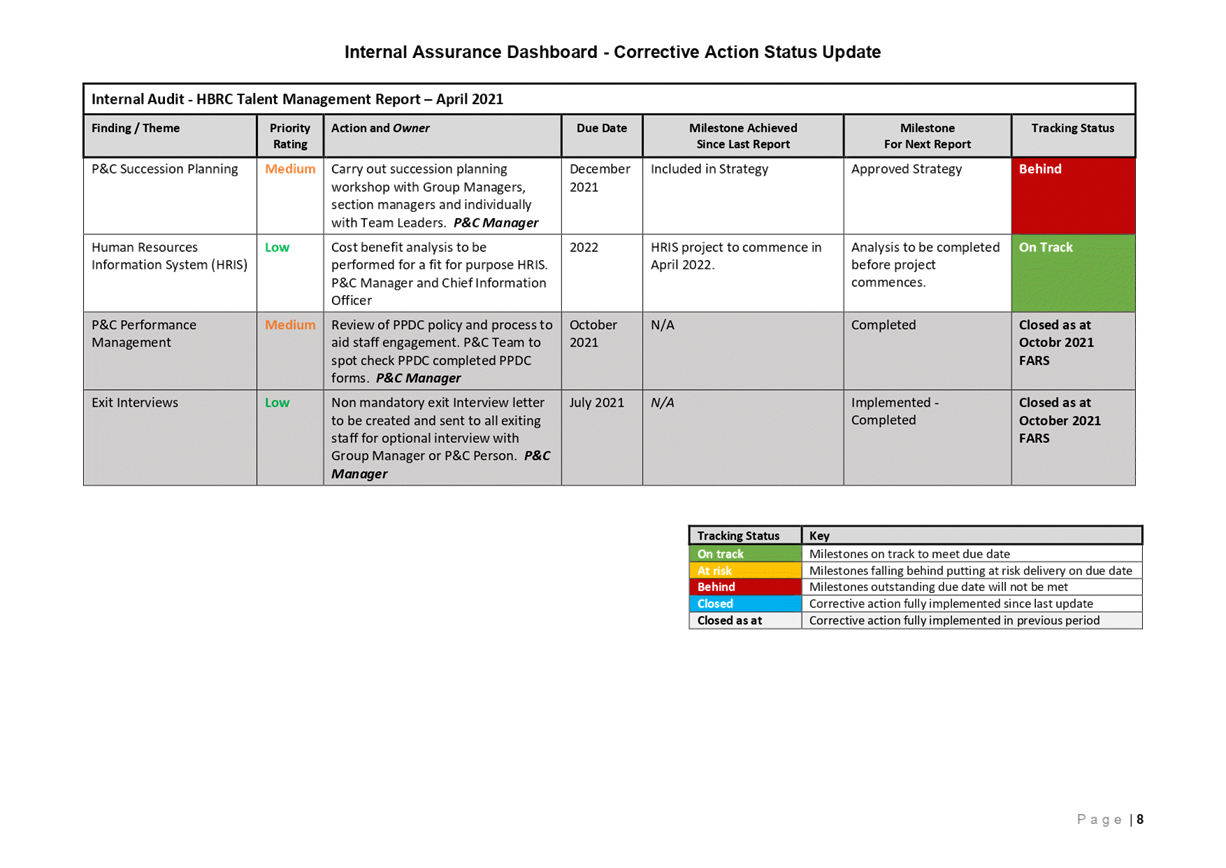


HAWKE’S BAY REGIONAL
COUNCIL
Finance
Audit & Risk Sub-committee
02 March
2022
Subject: Talent Management Internal
Audit Update
Reason for Report
1. This item provides the
Finance Audit and Risk Sub-committee (FARS) with an update on the talent
management internal audit corrective actions.
Background
2. Crowe undertook an Audit in
April 2021 to assess the Council’s talent management strategies and
processes against the NZ Public Service Commission’s Talent Management
Maturity Model, developed in 2017. To do this, they reviewed the following
People and Capability activities and assessed those activities against the
categories included in the Maturity Model:
2.1. Status of the People and
Capability strategy with regard to talent management
2.2. Recruitment and Selection
2.3. Reward and Performance
2.4. Training and Development
2.5. Employee and Leadership
Engagement.
3. The findings of the audit
were transferred into the Internal Assurance Dashboard as Corrective
Actions. Dates of milestones were inserted and these now show that the
following are now “behind”:
3.1. The People and Capability
Strategy, (People Plan) – a draft delivered by October 2021 to Executive
Leadership Team (ELT). Since delivered in October, further amendments
have been made and the document is now sitting with ELT to consider on14 Feb
2022)
3.2. People and Capability
(P&C) Objectives which form part of the draft People Plan have been
developed and delivered to ELT (14 Feb 2022)
3.3. Cultural values for
inclusion in P&C Strategy – these were identified at the
Leaders’ Forum and have now been inserted into the draft People Plan
3.4. Succession Planning
workshop with Group Managers and section managers/leaders is also part of the
draft People Plan and will now be part of the Talent Mapping process indicated
in the plan to commence in March 2022.
4. In hindsight the dates set
for completing the corrective actions were overly optimistic with what has
subsequently transpired for the P&C Team. However, good progress has
continued to be made on managing the critical risks facing the organisation as
we build off a low base of historic service maturity. The Crowe Audit
identified that the P&C services to the organisation, in terms of maturity,
are largely at the ‘just starting’ point. The organisation has
grown rapidly over the past 3-5 years and the capacity to focus on anything
much, other than recruitment, the yearly Performance Development Plan process,
Staff Survey and annual remuneration processes, has certainly resulted in a
slower response to the organisation than the P&C team would like. The
People Plan will provide the team with clear direction and the ability to now
plan ahead and schedule their work.
5. It is important to note
that the team, whilst not working to a People Plan previously, have continued
to support managers with performance management, disciplinary and restructuring
processes, whilst simultaneously being involved in the implementation of the
new TechOne system - inputting employee data and now learning how to extract
that data in order to inform our approach.
6. Improvements have also been
made to the various processes utilised across the organisation. For example,
recruitment processes – P&C now provide an end-to-end service to
managers from assisting to update job descriptions, size and price the jobs,
write job ads, shortlisting, pre-screening interviews, interviewing shortlisted
candidates, reference checking and the provision of contractual documentation,
which has improved the service to managers, applicants and new employees. As
well, the team have moved from running individual inductions to developing and
running group inductions for new employees, thereby creating efficiencies and
developing cohort relationships between new employees.
7. Managers/leaders have
attended briefing sessions run by the P&C team on how to benefit from the
Performance Development Plan annual process. The team have also developed an
on-line Exit Survey, an on-line On-boarding survey and continue to make
improvements to the annual Staff Survey and how the organisation responds to
what staff are telling us. The team has also been working closely with the
Civil Defence and Emergency Management Team and have taken on the coordination
of civil defence training, and during the last lockdown were tasked with
managing the CDEM roster. Over the past month, the development of the Covid
Vaccination and Business Continuity Policy was a major focus.
8. On top of the above, the
team itself has had two team members on parental leave who have since left to
undertake HR Management roles locally, and the team’s coordinator moved
to a role in another team and the new coordinator entered the team as TechOne
was being implemented. Payroll also joined the P&C team last year (from
Finance) and has required the team to adjust to learning a new system. With
support, the payroll issues are being worked through, but at times this has
been stressful and time-consuming for all those involved.
9. The P&C team was
involved in the development of the People Plan and are looking forward to
undertaking the work in the plan. They see this work as the ‘more
exciting’ aspects of their HR roles, where they themselves can learn and
grow.
10. The proposed People Plan
has three key focus areas: Leadership, People Experience and Sustainable
Workforce.
10.1. The main focus under
‘Leadership’ is development of people leaders and working with and
through them to foster and promote the behaviours and cultural values they have
agreed to as a leadership group
10.2. ‘People
Experience’ is about endeavouring to improve the experience our people
have throughout their time with the Hawke’s Bay Regional Council (HBRC).
We will be gathering data, analysing it and making improvements to the services
we provide staff. Included in the plan is the development of centrally
coordinated generic training which will be made available to staff throughout the
year. The intention is to strengthen staff training and development to improve
performance and confidence, as well as job satisfaction.
10.3. ‘Sustainable
Workforce’ focuses on the development of a competency framework,
undertaking a talent mapping exercise and ensuring we employ the
‘right’ people. There is also work to be done to align the
competencies already defined in any existing tools with any new solutions
developed to ensure that all these competencies are captured within the Competency
Framework (yet to be developed).
10.4. We will also be gathering
data and information so that we can better understand our current and future
workforce needs and build further targeted initiatives and interventions around
critical skill dependencies, such as we have undertaken for river engineers. We
will also be focusing on students as a potential permanent workforce and
developing a Corporate Alumni to keep in touch with our ex-employees who, along
with current staff are our ambassadors. Ex-employees may wish to return to HBRC
and bring back with them the skills and experiences they have gained elsewhere.
11. The People Plan is both a
strategy and a plan to shift the HBRC’s Talent Management practices as
assessed by Crowe along the maturity model. The P&C Manager proposes to
report to the Sub-committee on progress against the plan annually.
Decision Making Process
12. Council and its committees
are required to make every decision in accordance with the requirements of the
Local Government Act 2002 (the Act). Staff have assessed the requirements in
relation to this item and have concluded:
12.1. Any decision of the
sub-committee is in accordance with the Terms of Reference and decision-making
delegations adopted by Hawke’s Bay Regional Council 25 March 2020,
specifically the Finance, Audit and Risk Sub-committee shall have
responsibility and authority to:
12.1.1. Receive the internal and
external audit report(s) and review actions to be taken by management on
significant issues and recommendations raised within the reports.
12.1.2. Ensure that recommendations
in audit management reports are considered and, if appropriate, actioned by
management.
12.1.3. As this report is for
information only, the decision-making provisions do not apply.
Recommendations
That
the Finance, Audit and Risk Sub-committee:
1. Receives and notes the
‘Talent Management Internal Audit Update’ staff report.
2. Confirms that management
actions undertaken or planned for the future adequately respond to the findings
and recommendations of the 2021 internal audit.
3. Reports to the Corporate
and Strategic Committee, the Sub-committee’s satisfaction that the Talent
Management Internal Audit Update provides adequate evidence of the adequacy
of the management actions undertaken or planned to respond to the findings and
recommendations from the Crowe Audit of the Council’s talent management
strategies and processes undertaken in April 2021.
Authored by:
|
Liana Monteith
Manager People and Capability
|
|
Approved by:
|
James Palmer
Chief Executive
|
|
Attachment/s
There are no attachments for this report.
HAWKE’S BAY REGIONAL
COUNCIL
Finance
Audit & Risk Sub-committee
02 March
2022
Subject: Internal Assurance Dashboard
- Cyber Security Corrective Actions Status Update
That
Hawke’s Bay Regional Council excludes the public from this section of the
meeting, being Agenda Item 14 Internal Assurance Dashboard - Cyber Security
Corrective Actions Status Update with the general subject of the item to be
considered while the public is excluded; the reasons for passing the resolution
and the specific grounds under Section 48 (1) of the Local Government Official
Information and Meetings Act 1987 for the passing of this resolution being:
|
GENERAL
SUBJECT OF THE ITEM TO BE CONSIDERED
|
REASON
FOR PASSING THIS RESOLUTION
|
GROUNDS
UNDER SECTION 48(1) FOR THE PASSING OF THE RESOLUTION
|
|
Internal Assurance
Dashboard - Cyber Security Corrective Actions Status Update
|
7(2)(f)(ii) The
withholding of the information is necessary to maintain the effective conduct
of public affairs through the protection of such members, officers,
employees, and persons from improper pressure or harassment.
s7(2)(j) That the public
conduct of this agenda item would be likely to result in the disclosure of
information where the withholding of the information is necessary to prevent
the disclosure or use of official information for improper gain or improper
advantage.
|
The Council is specified,
in the First Schedule to this Act, as a body to which the Act applies.
|
Authored by:
|
Olivia Giraud-Burrell
Quality & Assurance Advisor
|
Helen Marsden
Risk & Corporate Compliance
Manager
|
Approved by:
|
Jessica Ellerm
Group Manager Corporate Services
|
|
Williams,
B & Besednjak, T. (2007). EM112 Gumeracha Eucalypt Climate Change Trials
2007 Interim Report. Retrieved from:



















































































